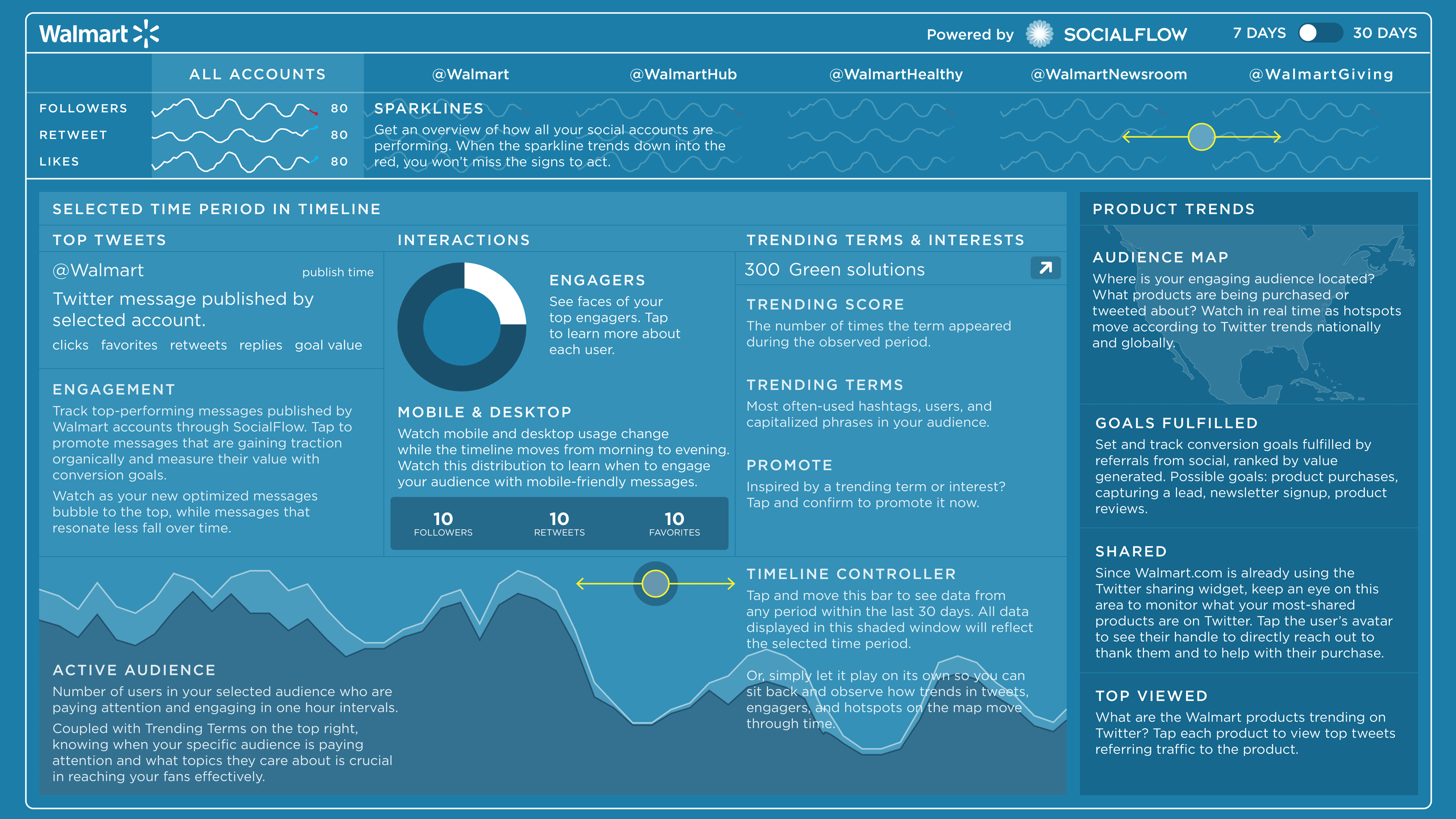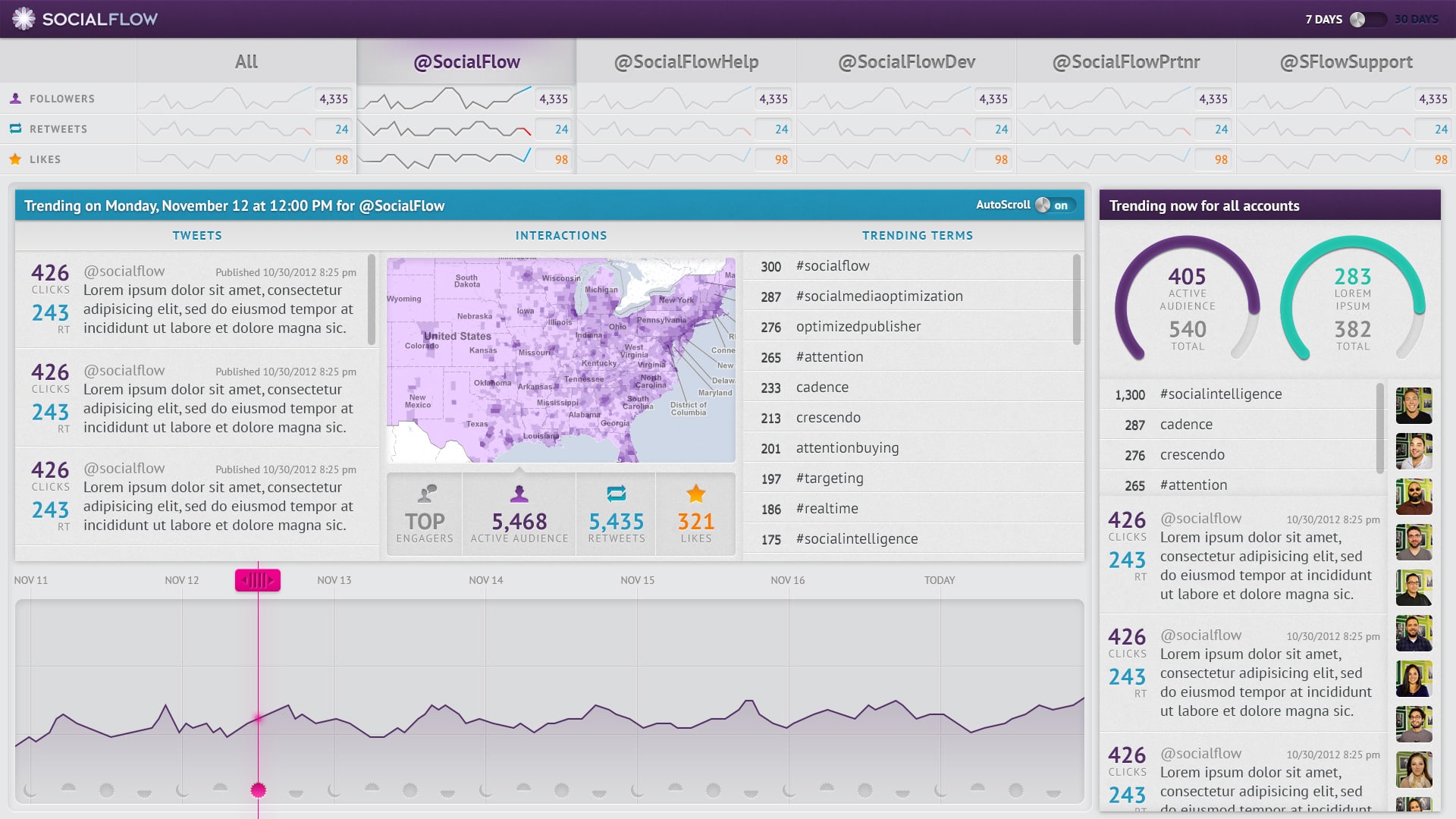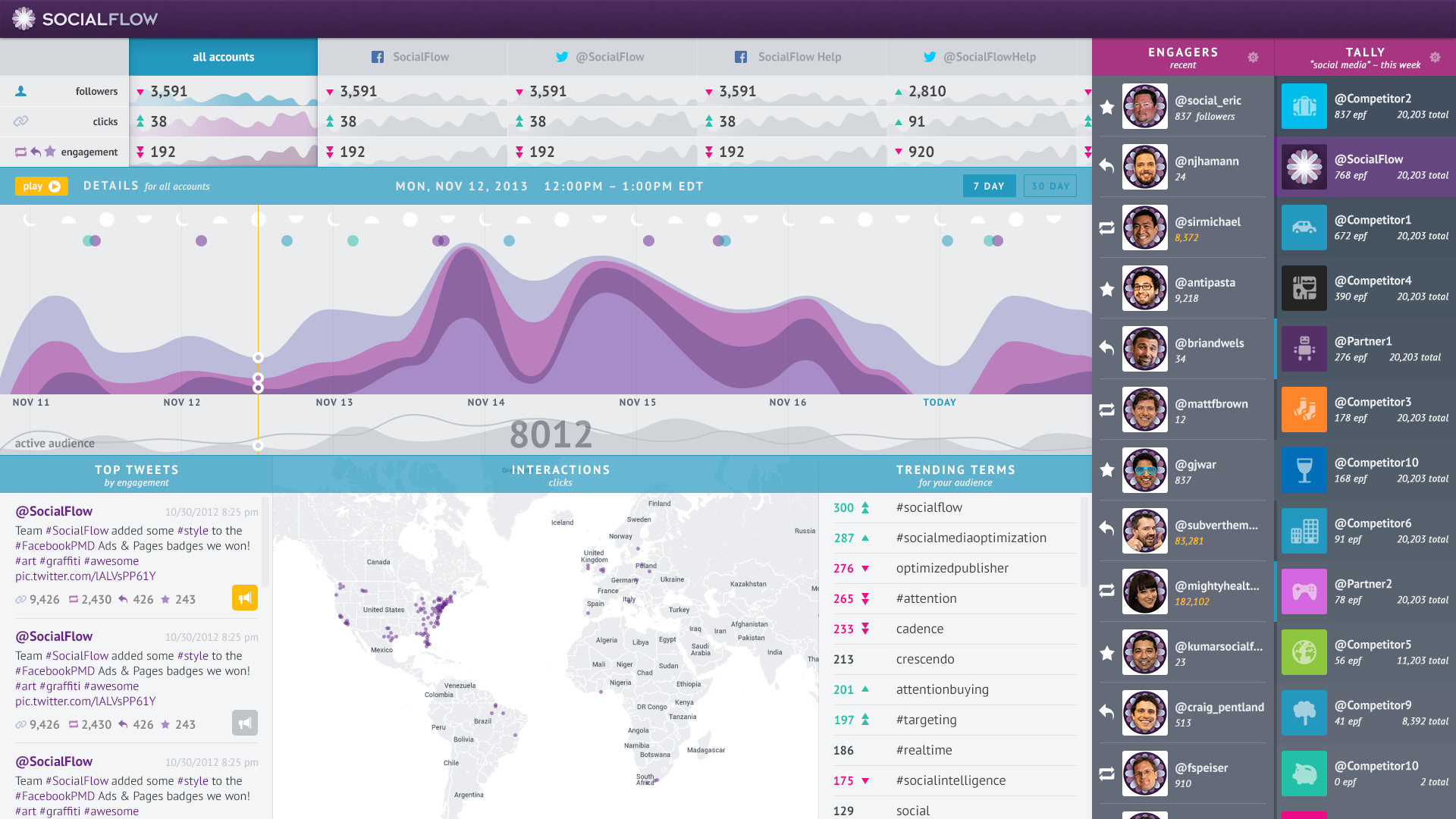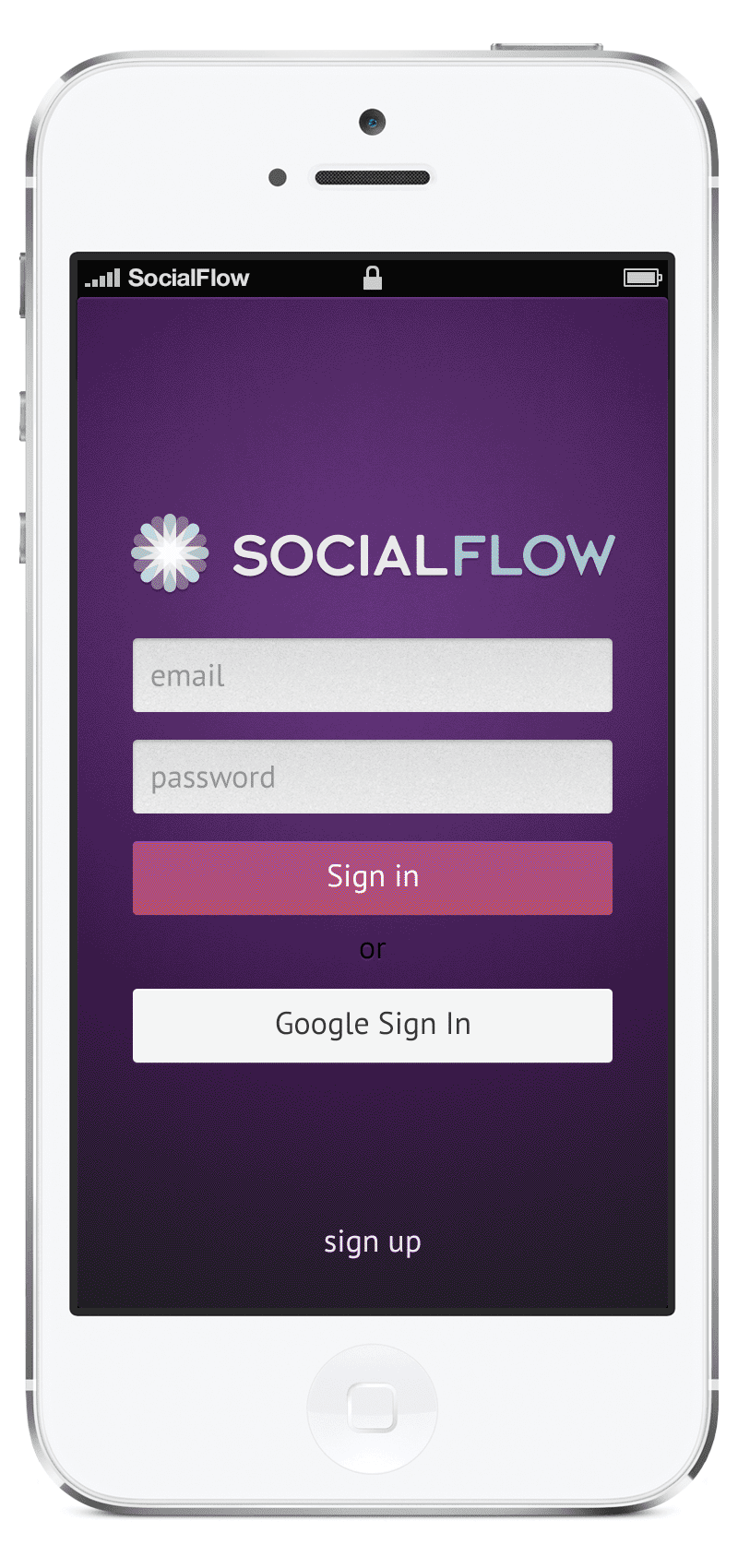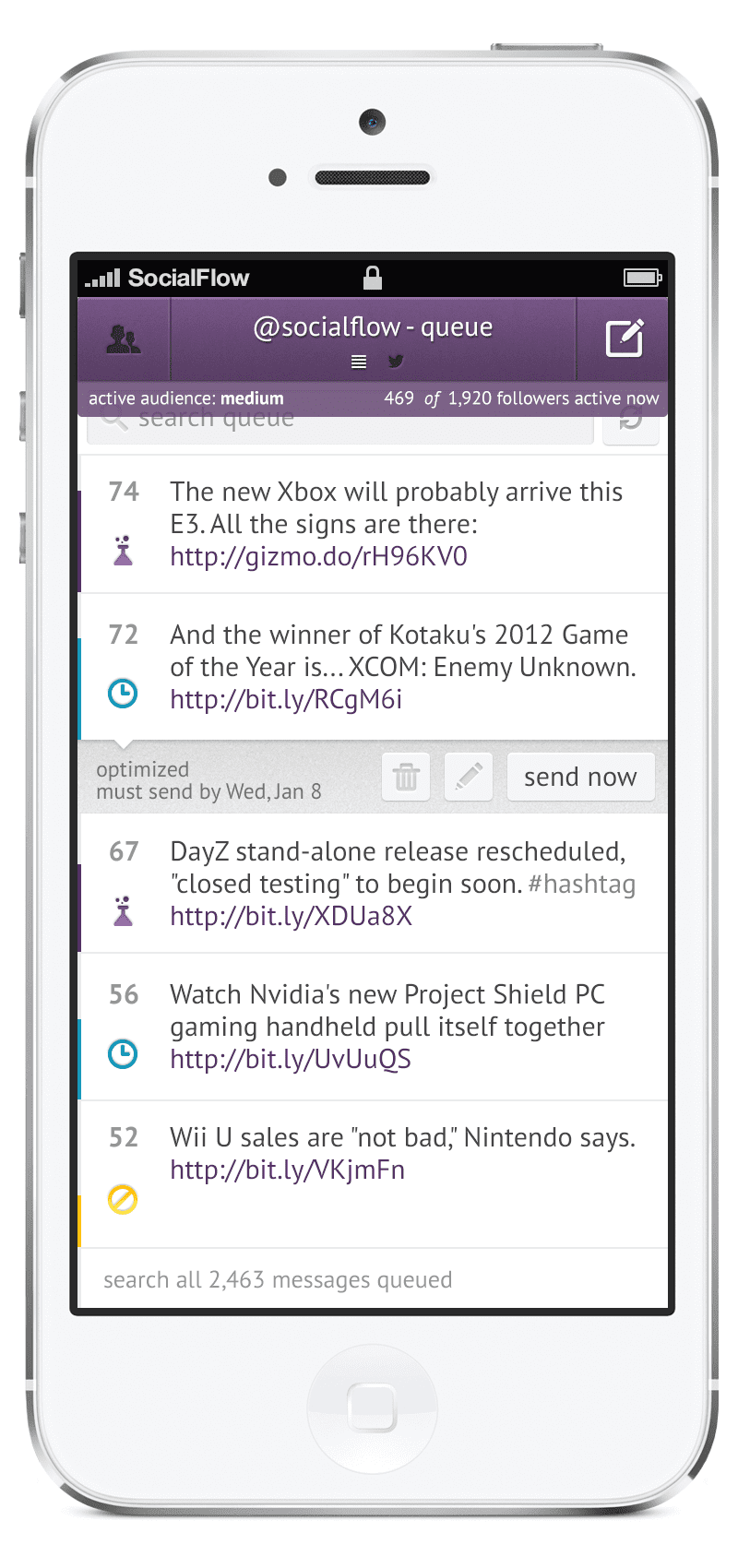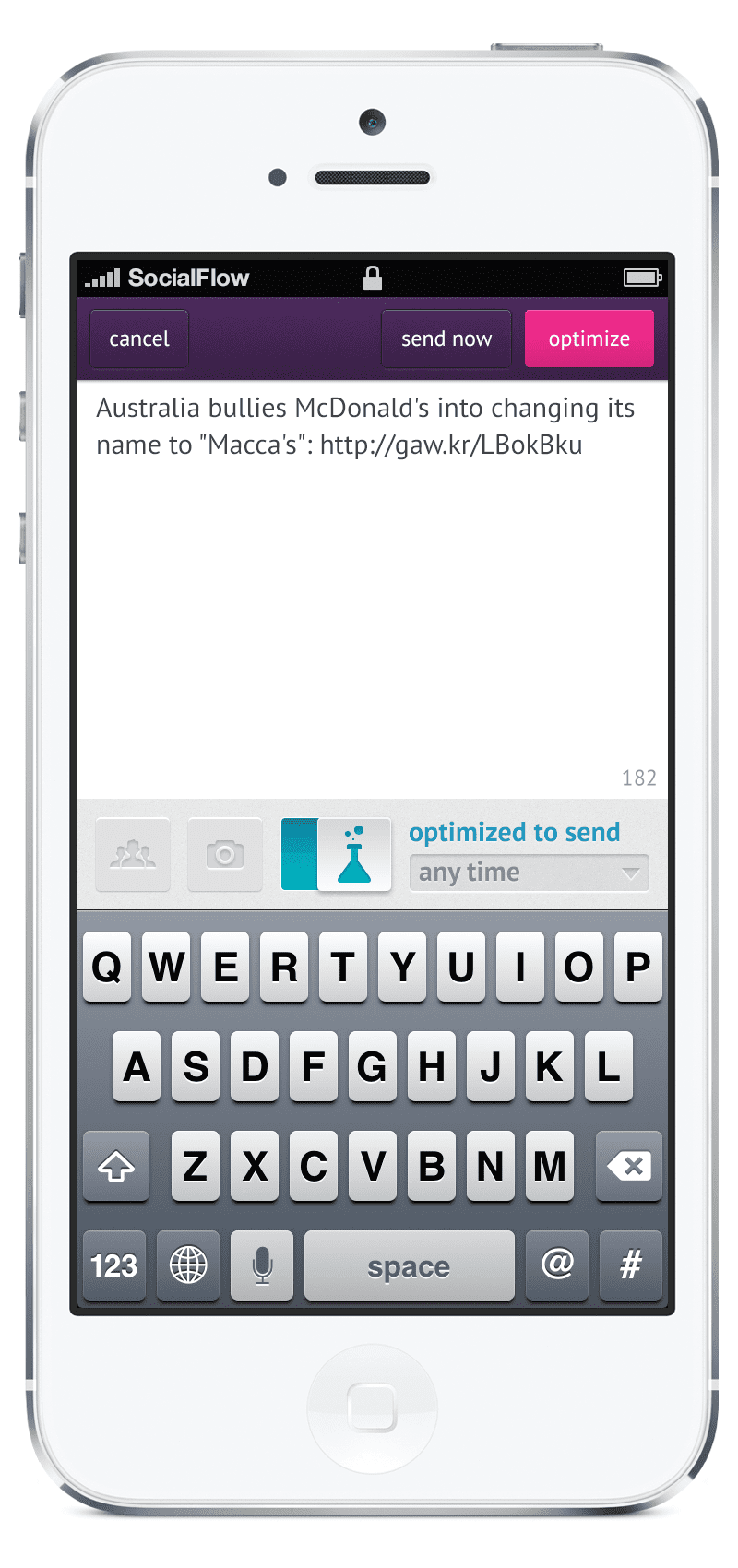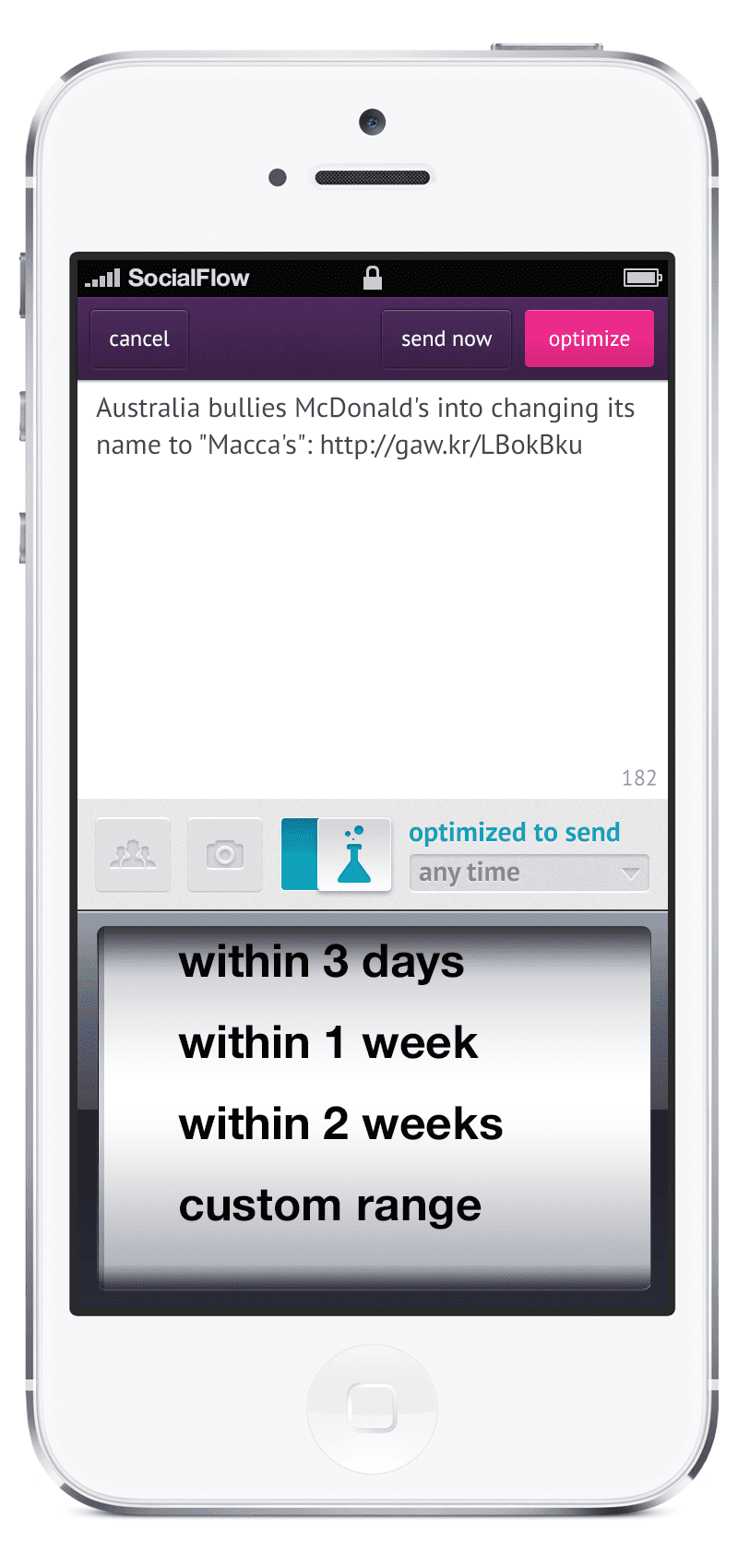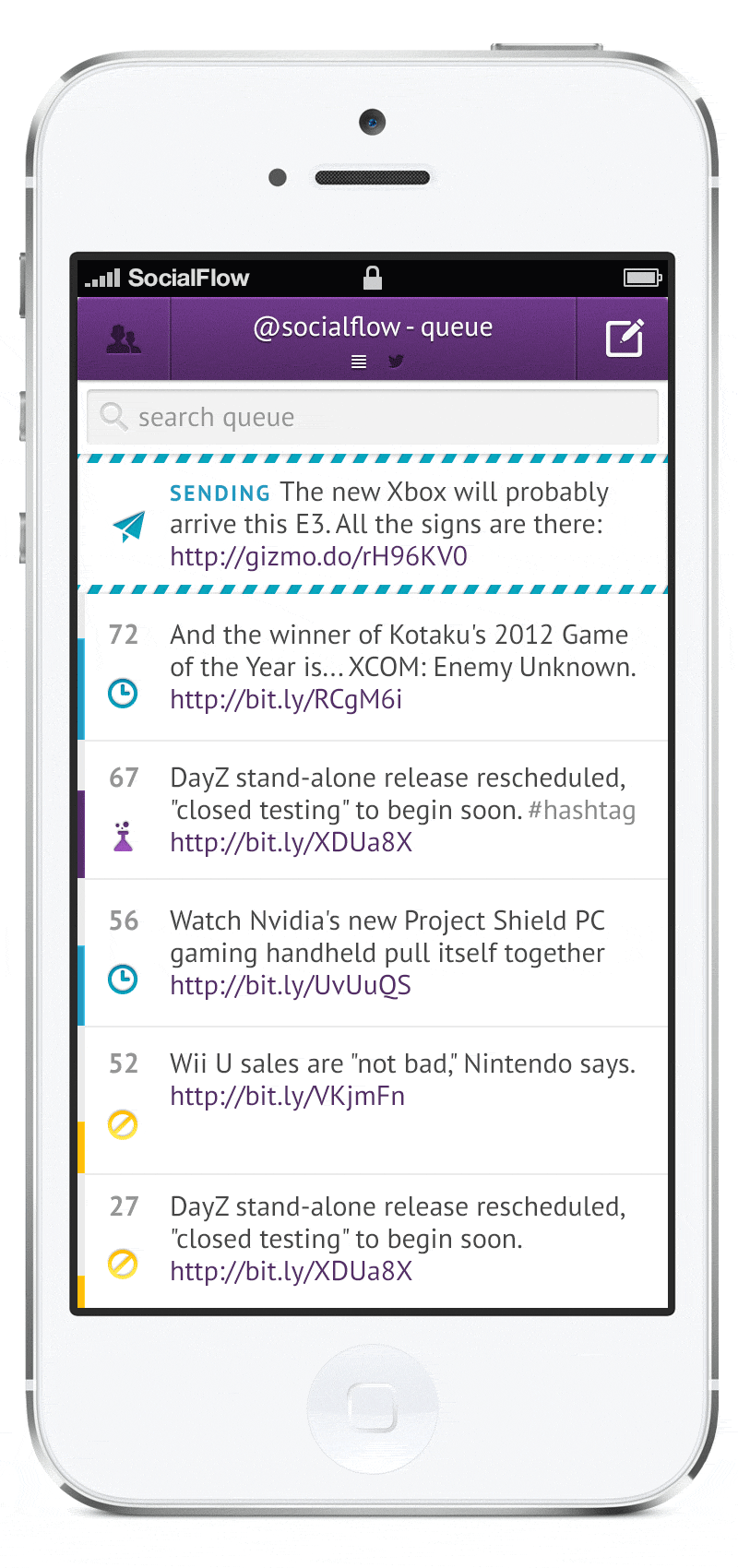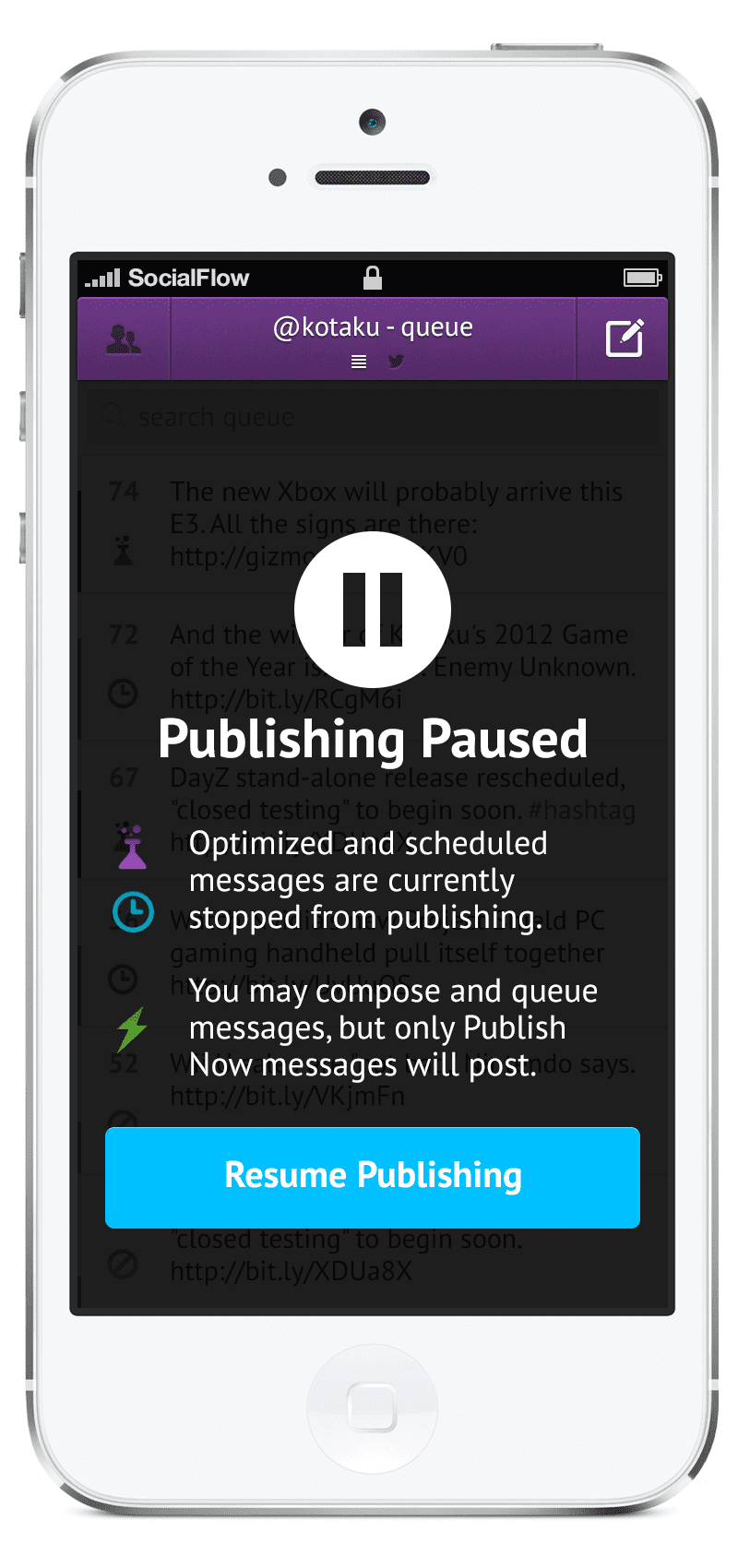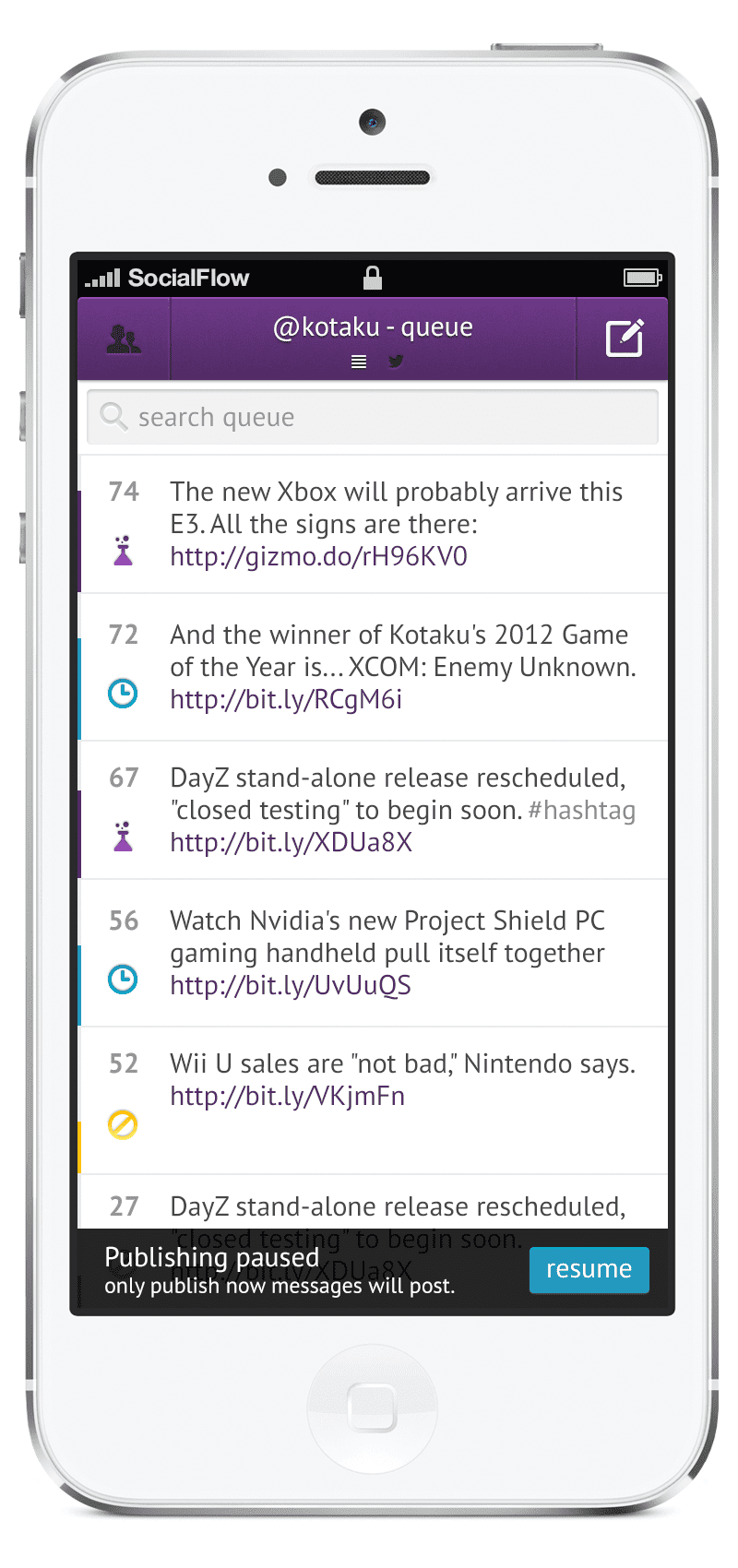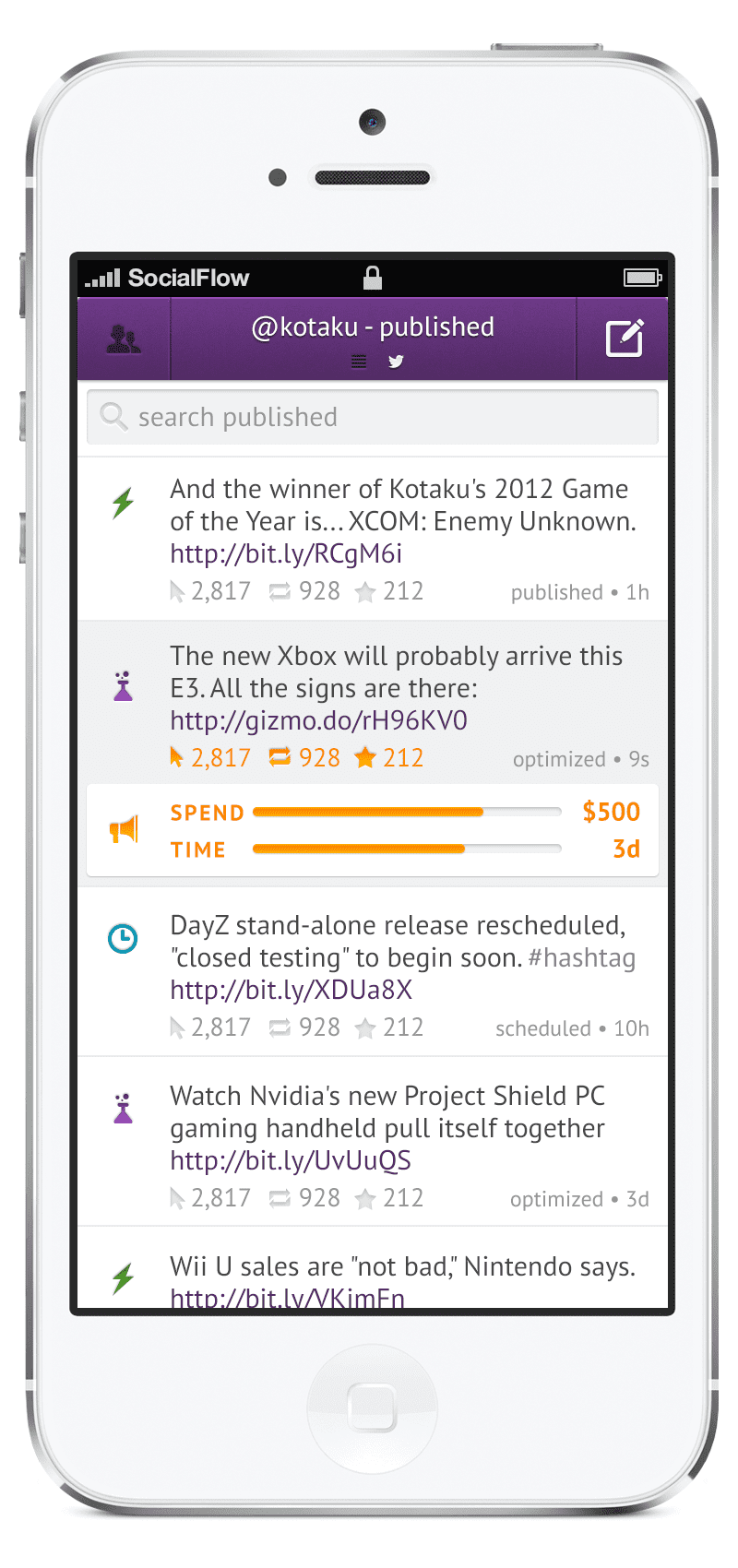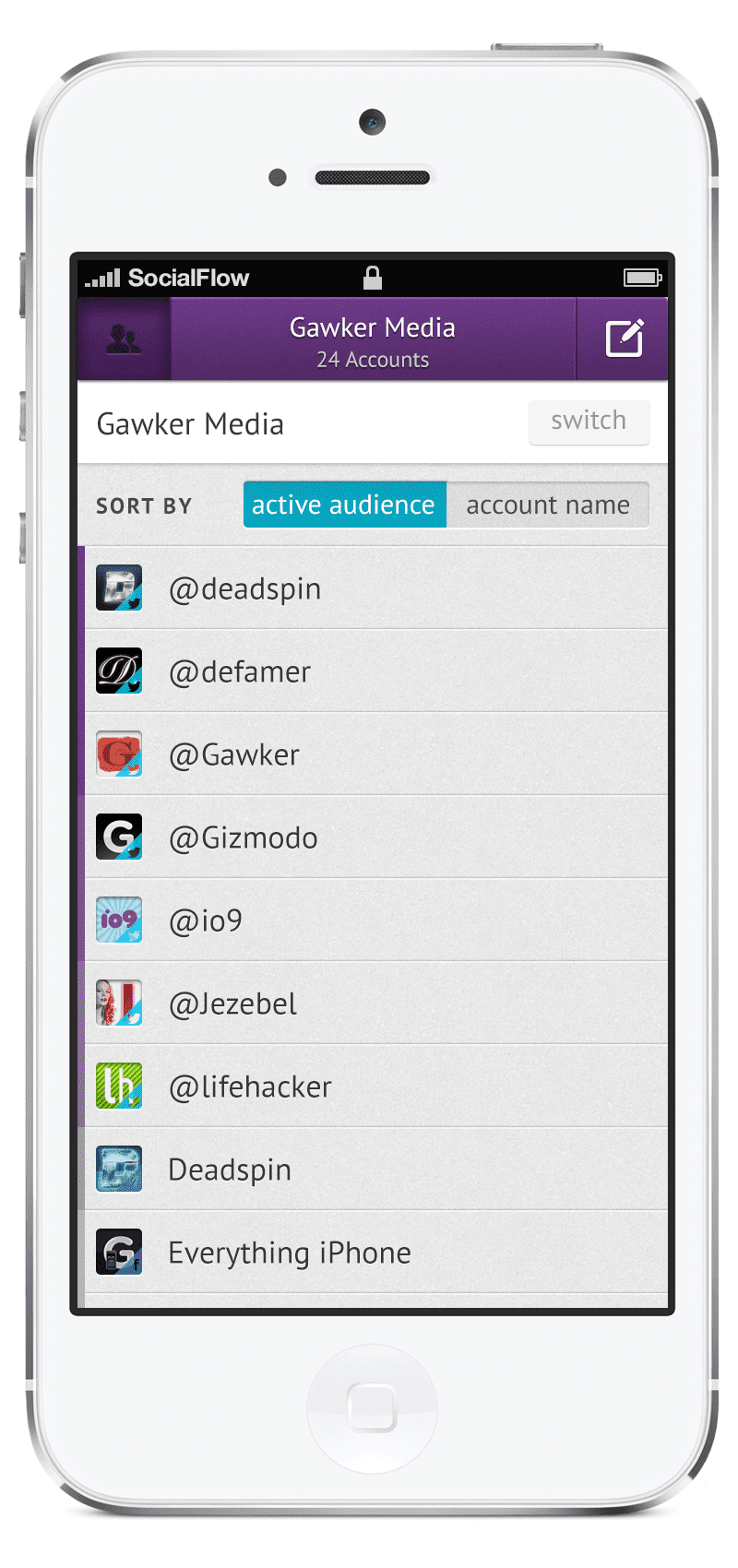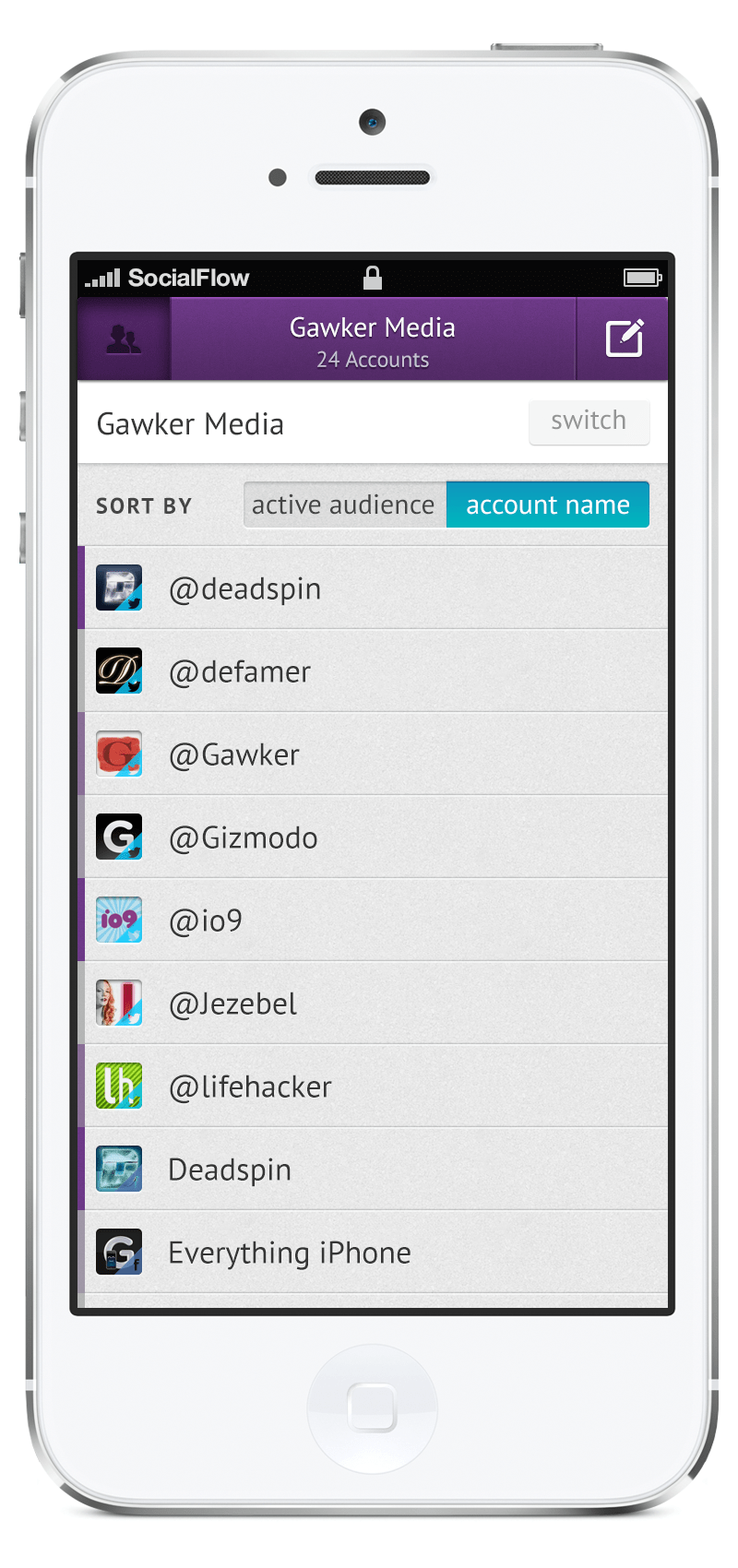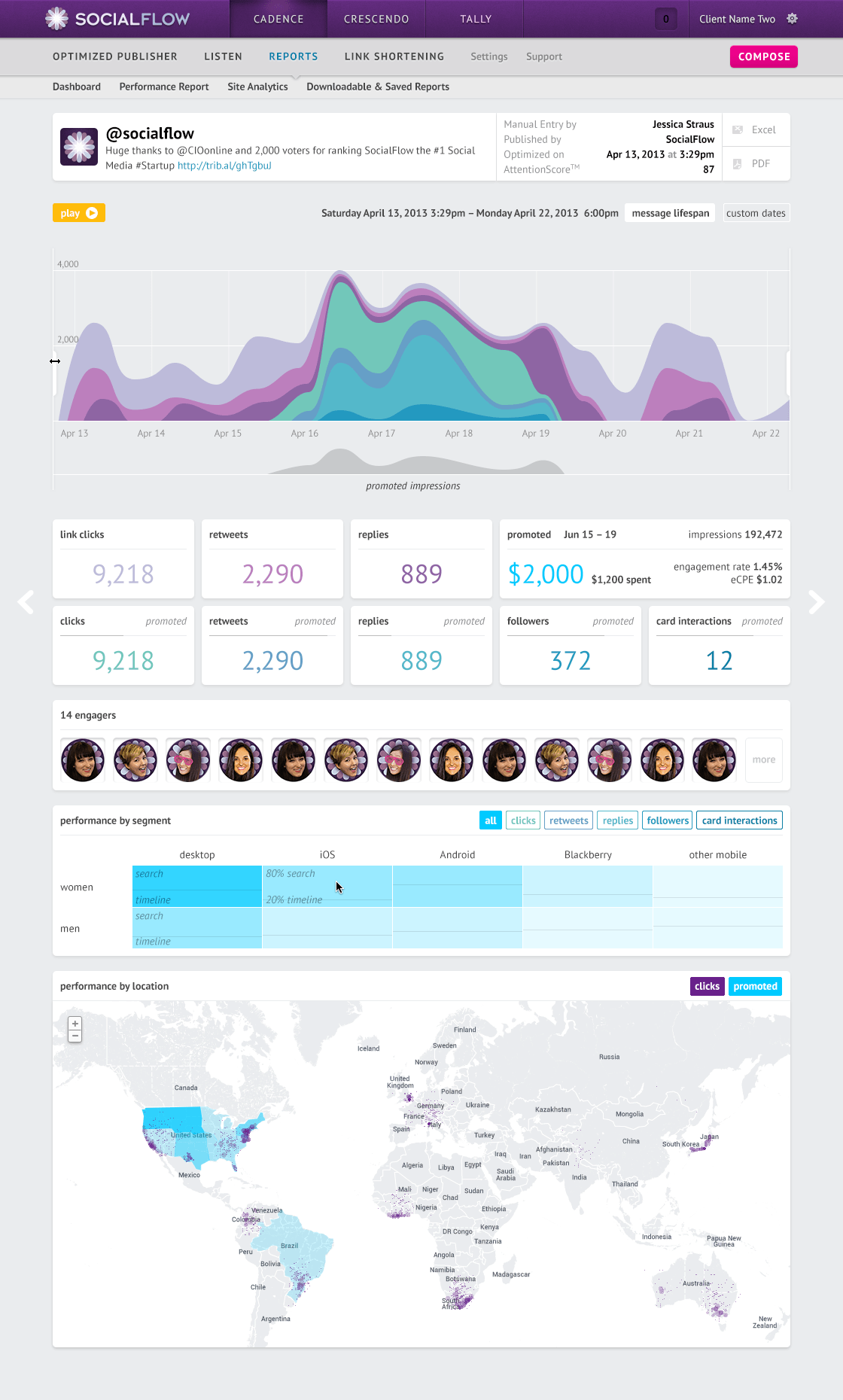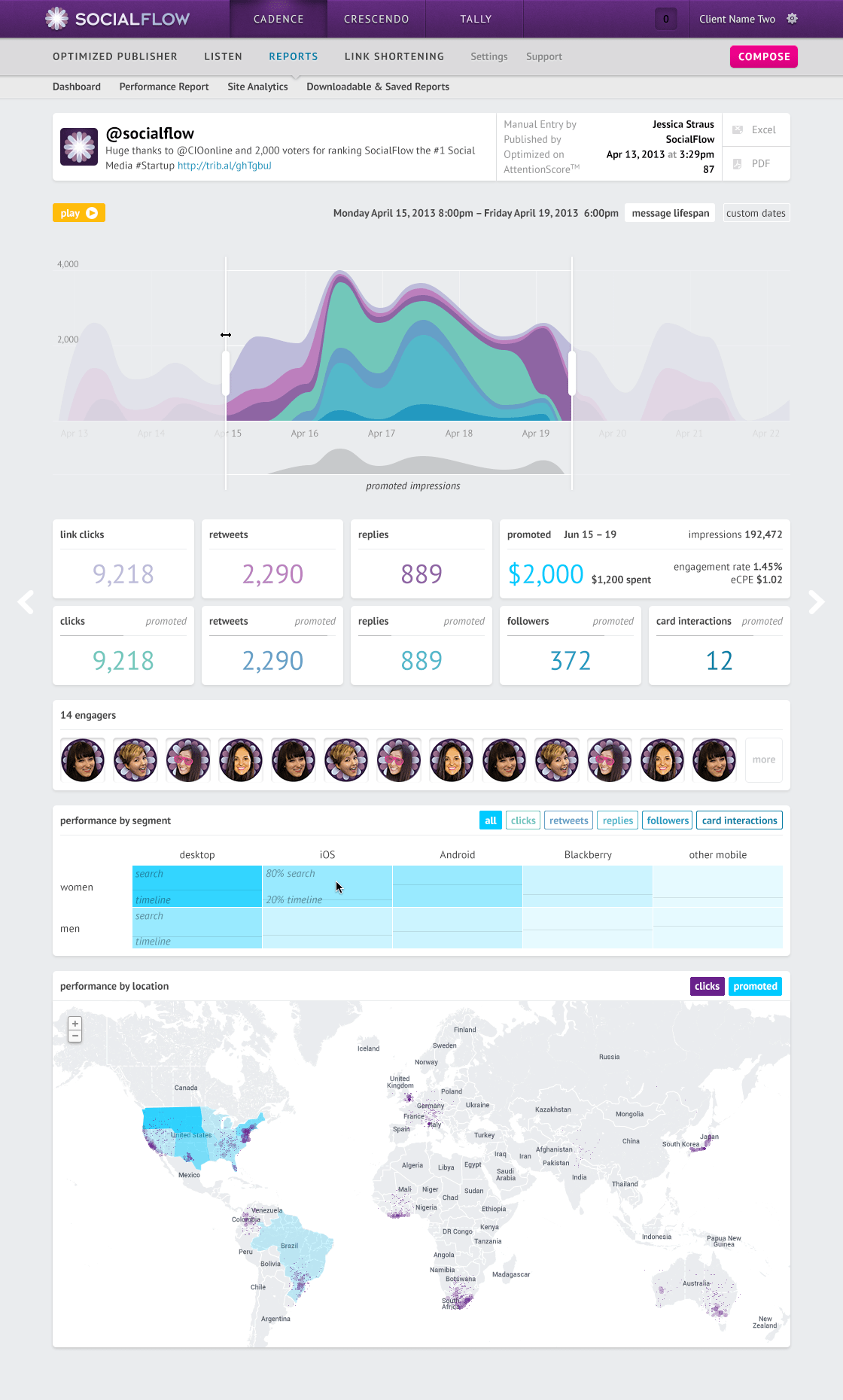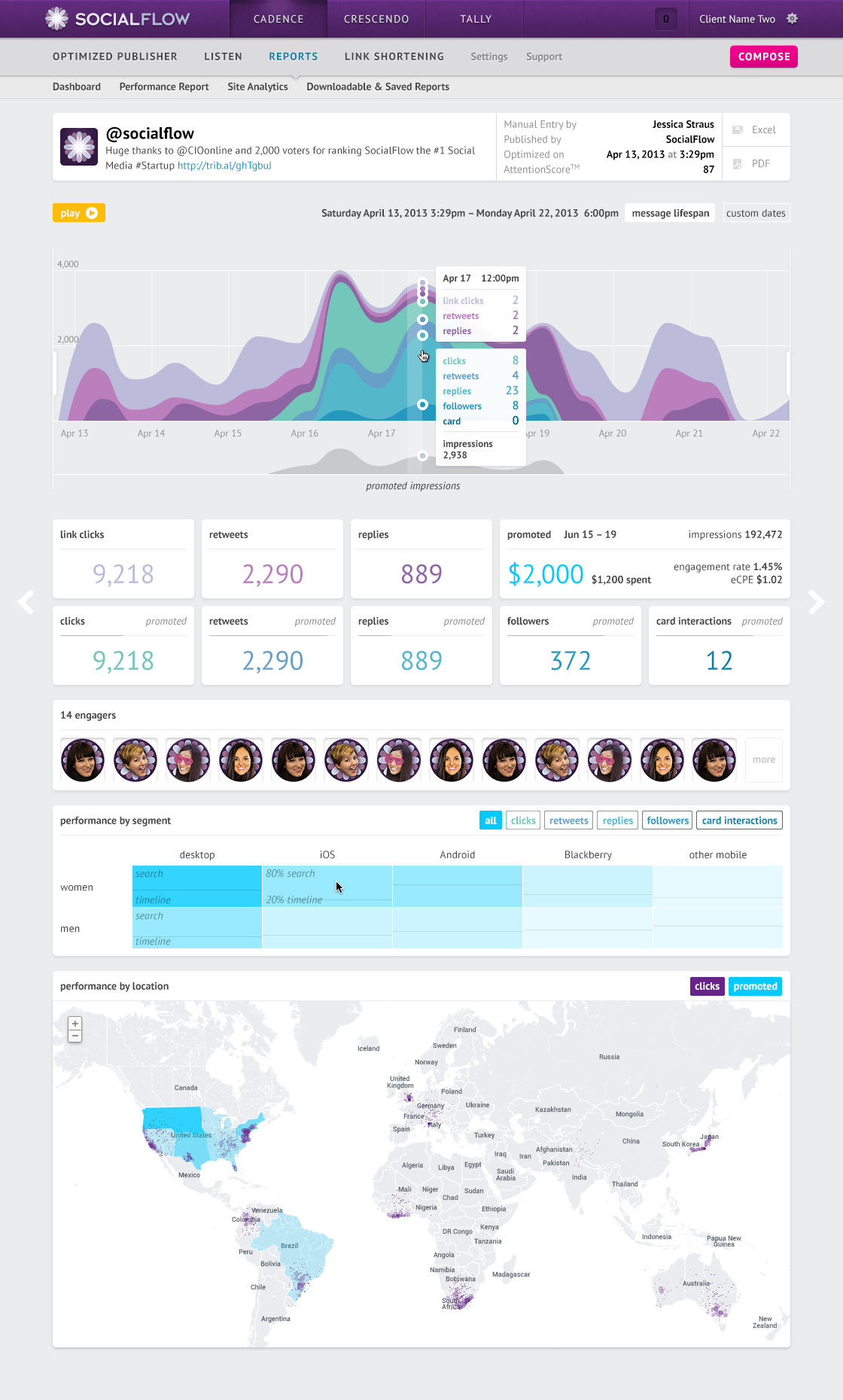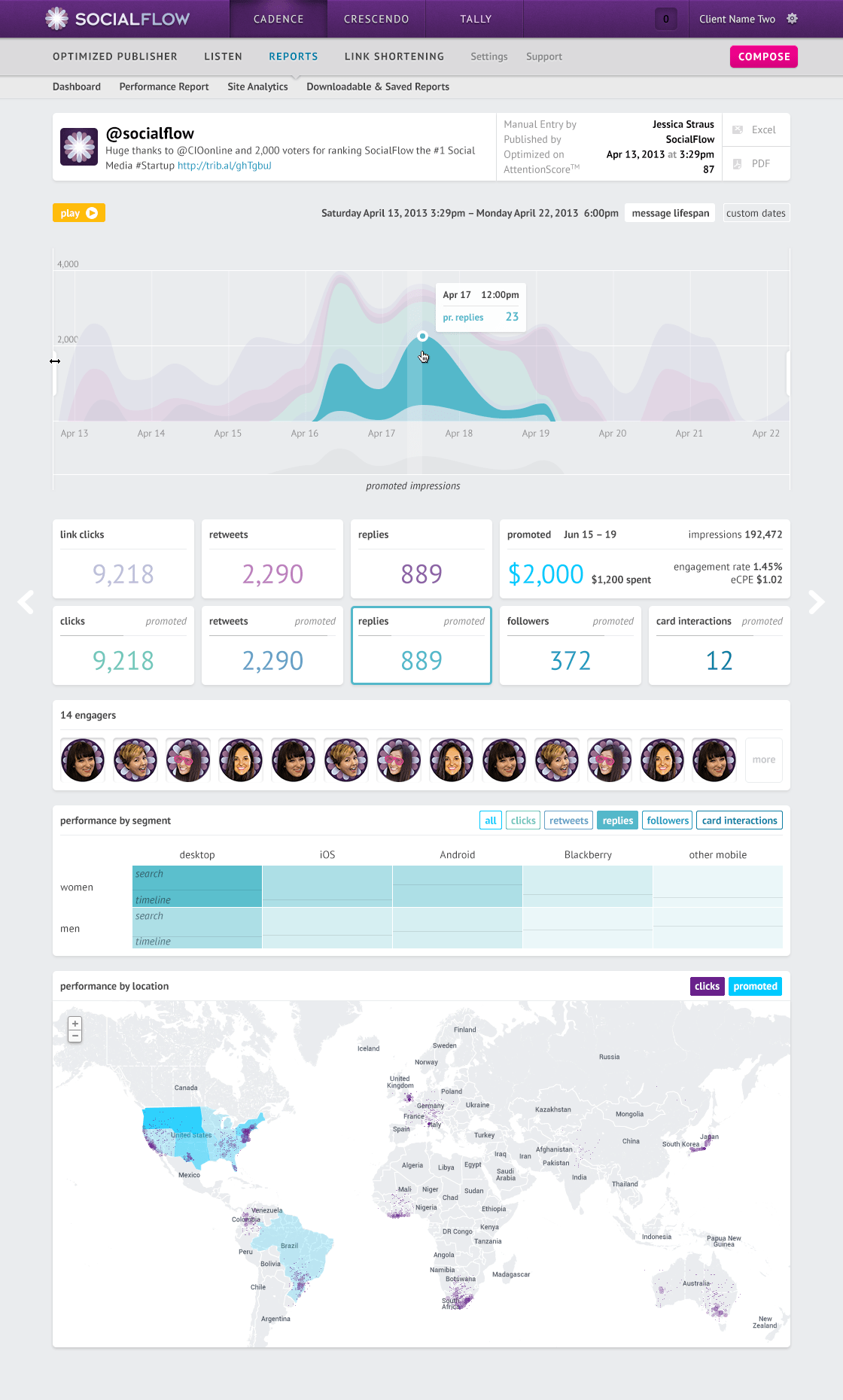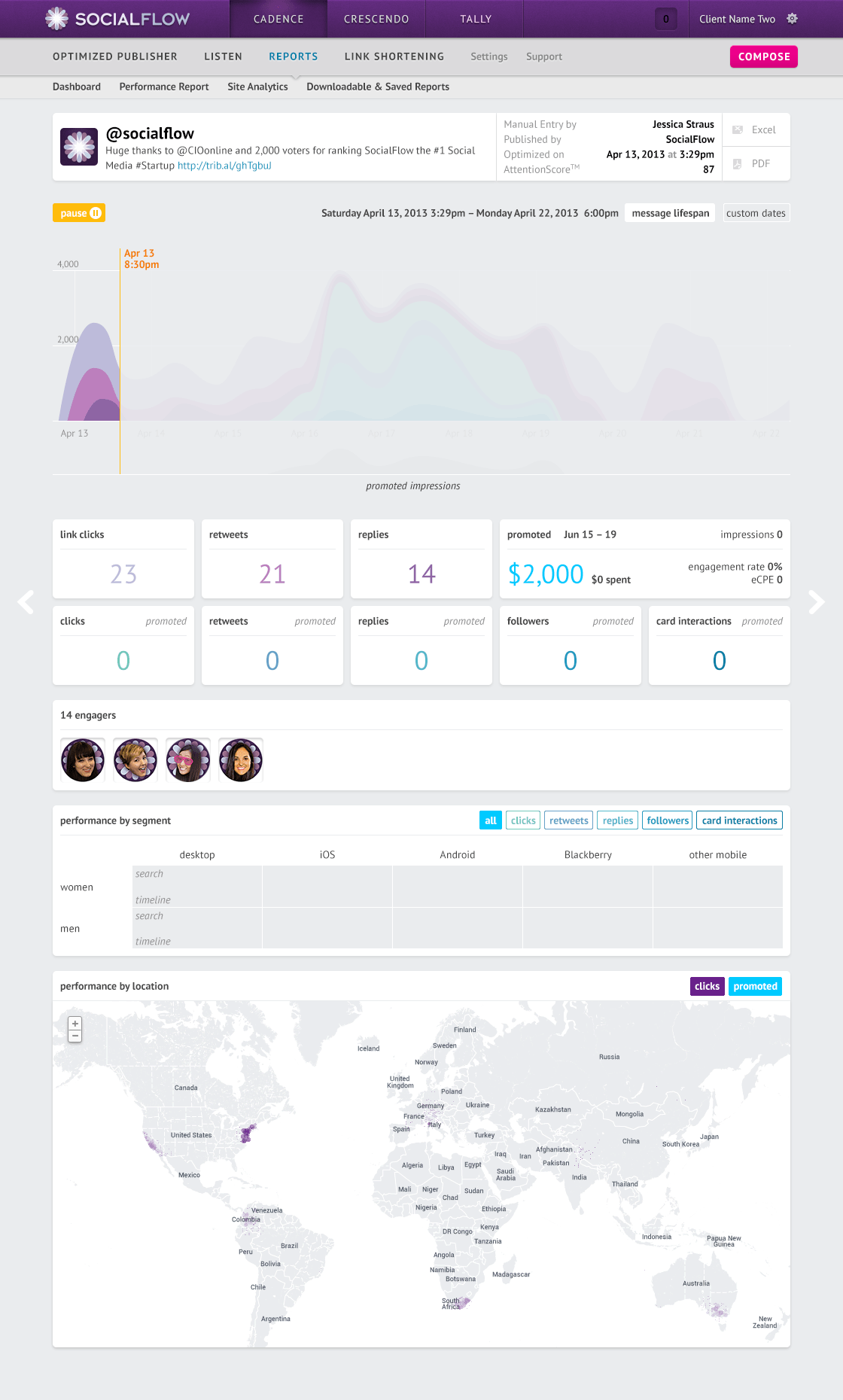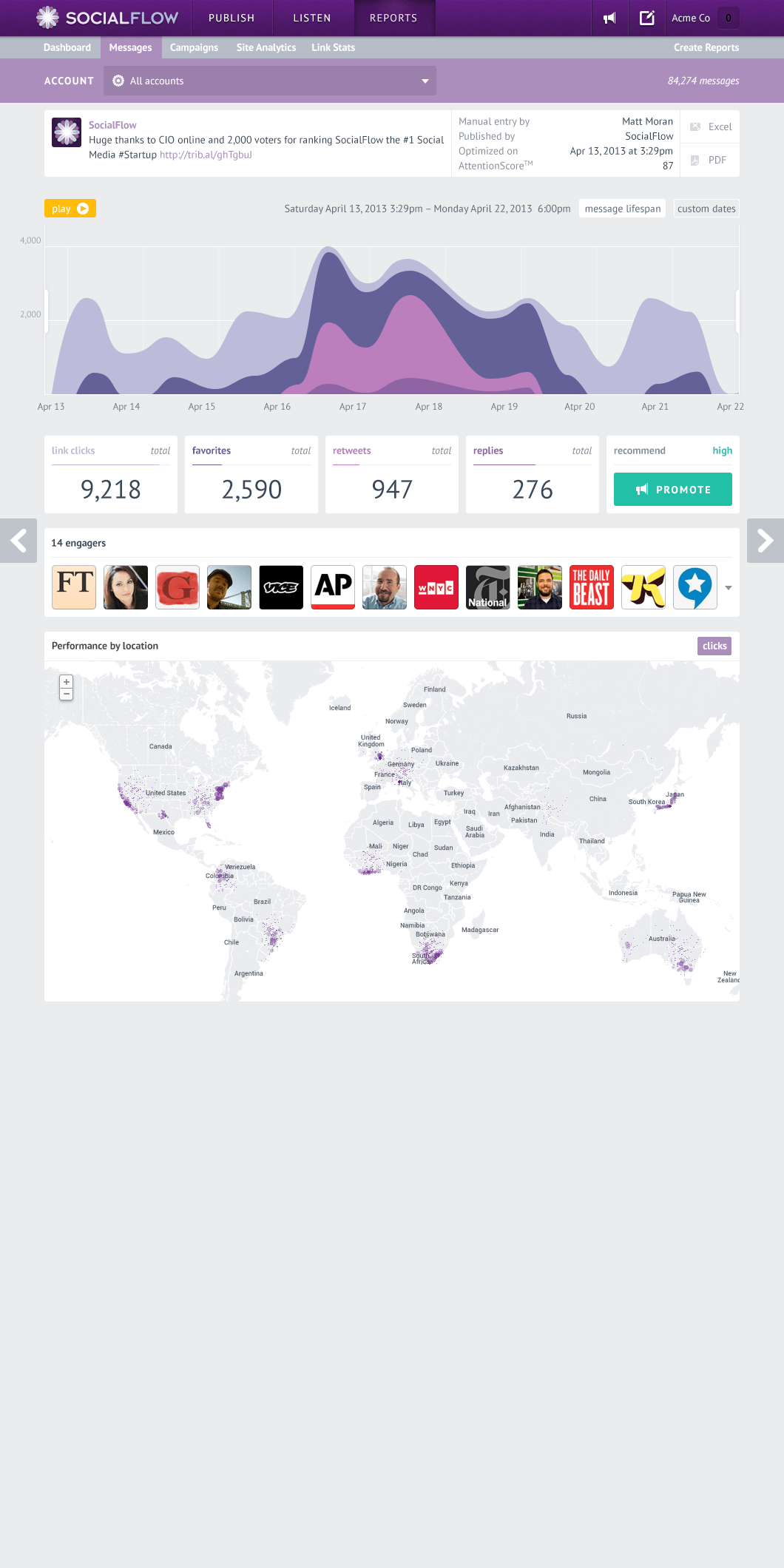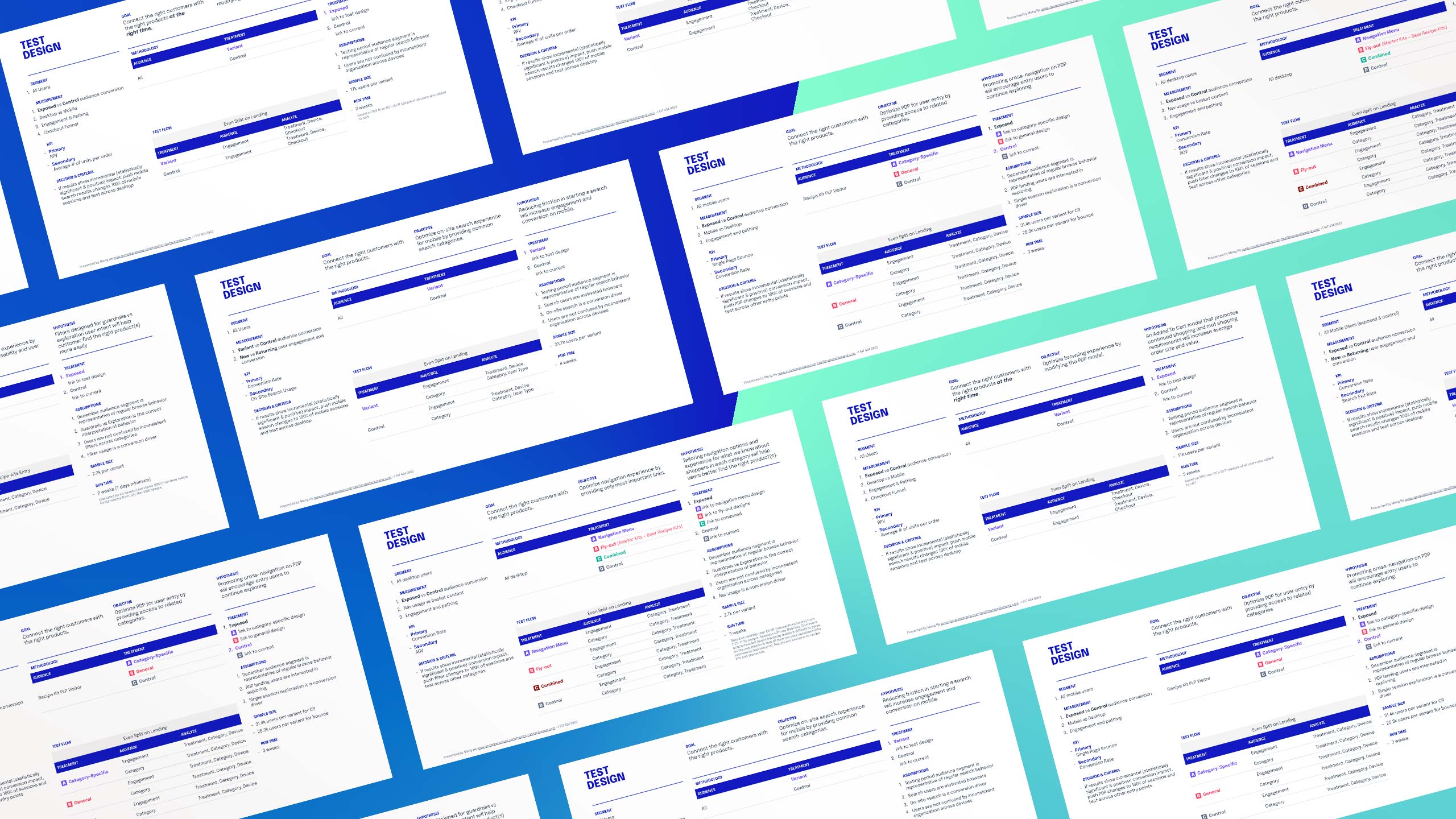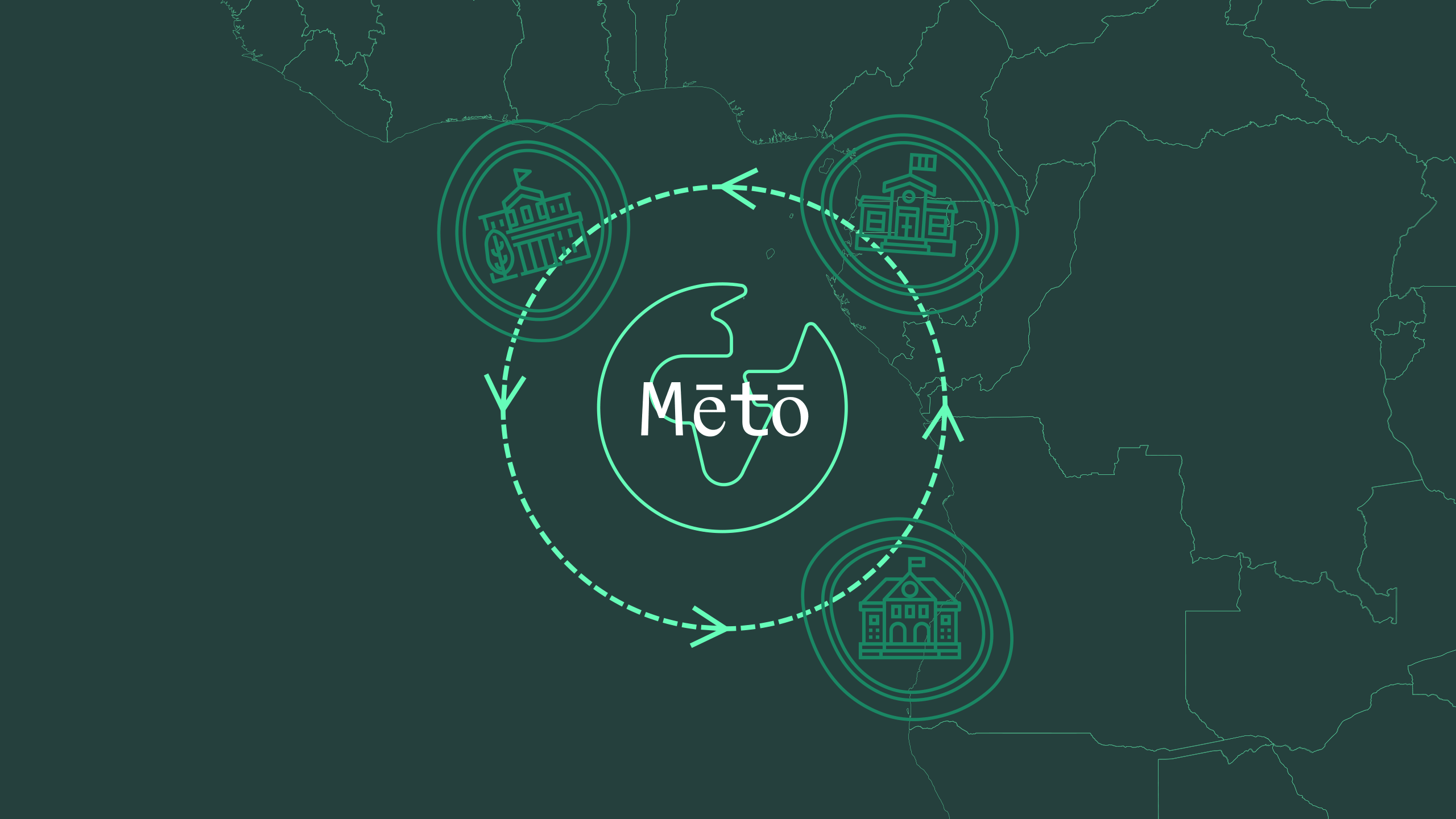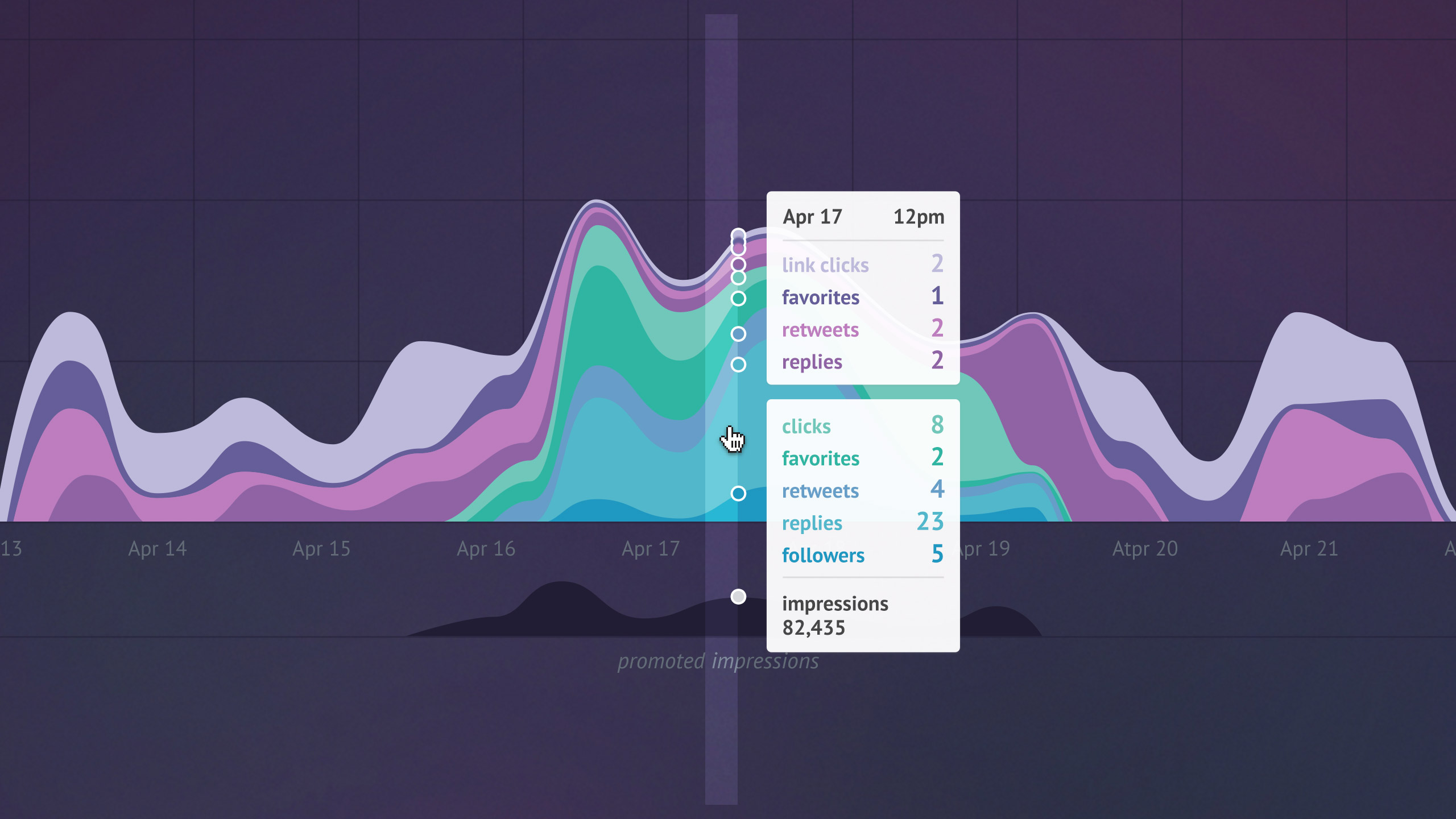
"When you see a news item in your social feed, the odds are good that it came through SocialFlow."
From 2012–2013, I led design at SocialFlow, an enterprise social media optimization platform trusted by the AP, NY Times, CNN, WSJ, and even The White House to make the most of their unique audience's attention—making the right post, at the right time, to the right person.
SocialFlow was on the forefront of understanding how movements, events, and messages go viral, and how social media has shaped the attention economy. As one of the few partners in the world with access to the full Twitter Firehose, SocialFlow researched how the Twittersphere collectively pieced together information to break the news of the death of Osama Bin Laden ahead of the official announcement, how memes like The Harlem Shake spread globally, and how movements like KONY2012 gained traction not from coastal liberal media, but from mid-sized conservative cities in middle America.
During my time there, we built the paid amplification platform for Facebook and Twitter advertising to help our clients make the most of their marketing budget automatically, a browser plugin and mobile app so publishers could use us as easily from the couch as the front lines, a social media dashboard that clients displayed in their offices to keep their finger on the pulse of their audience, and iterated on the core publishing platform to help publishers and brands reach their audiences.

branding
Starting with the logo and brand style guide by Tishon Woolcock, we expanded on this core identity to grow in lockstep with the product offerings.
As we began to help publishers and brands with paid amplifications, we introduced organic (shades of purple, our core bread and butter color) and paid (shades of green—the opposite end of the color wheel and the color of our daily bread) color palettes. The UI design system similarly is bifurcated into organic and promoted to give users a visual cue whether they're publishing organically or amplifying with paid. The company logo also became a parent to a family of product logos that take inspiration from the original.
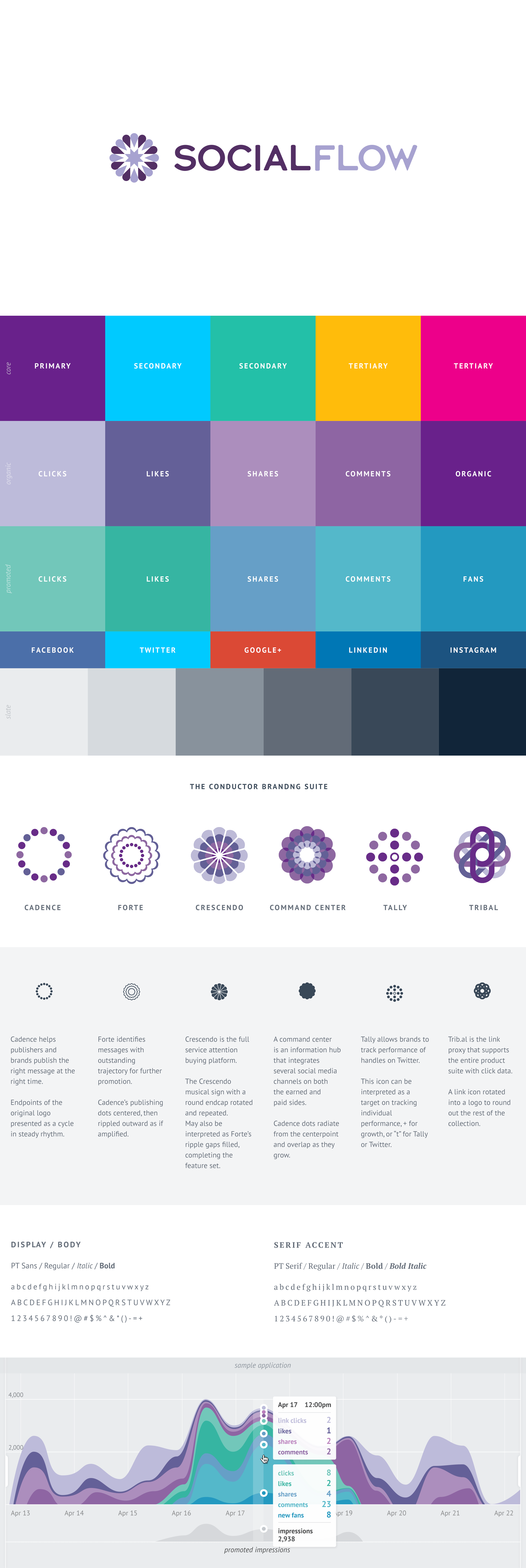
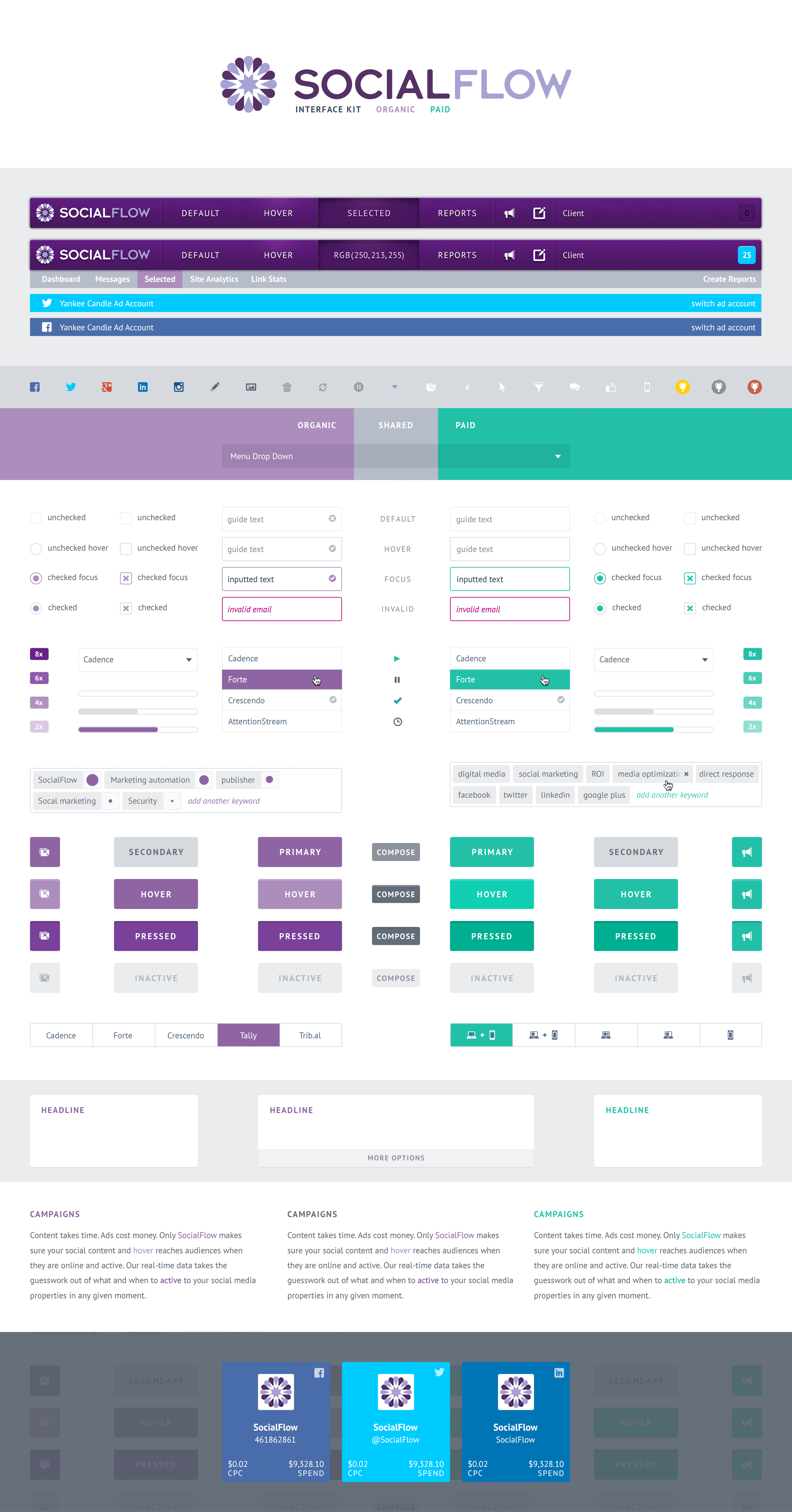

product
product
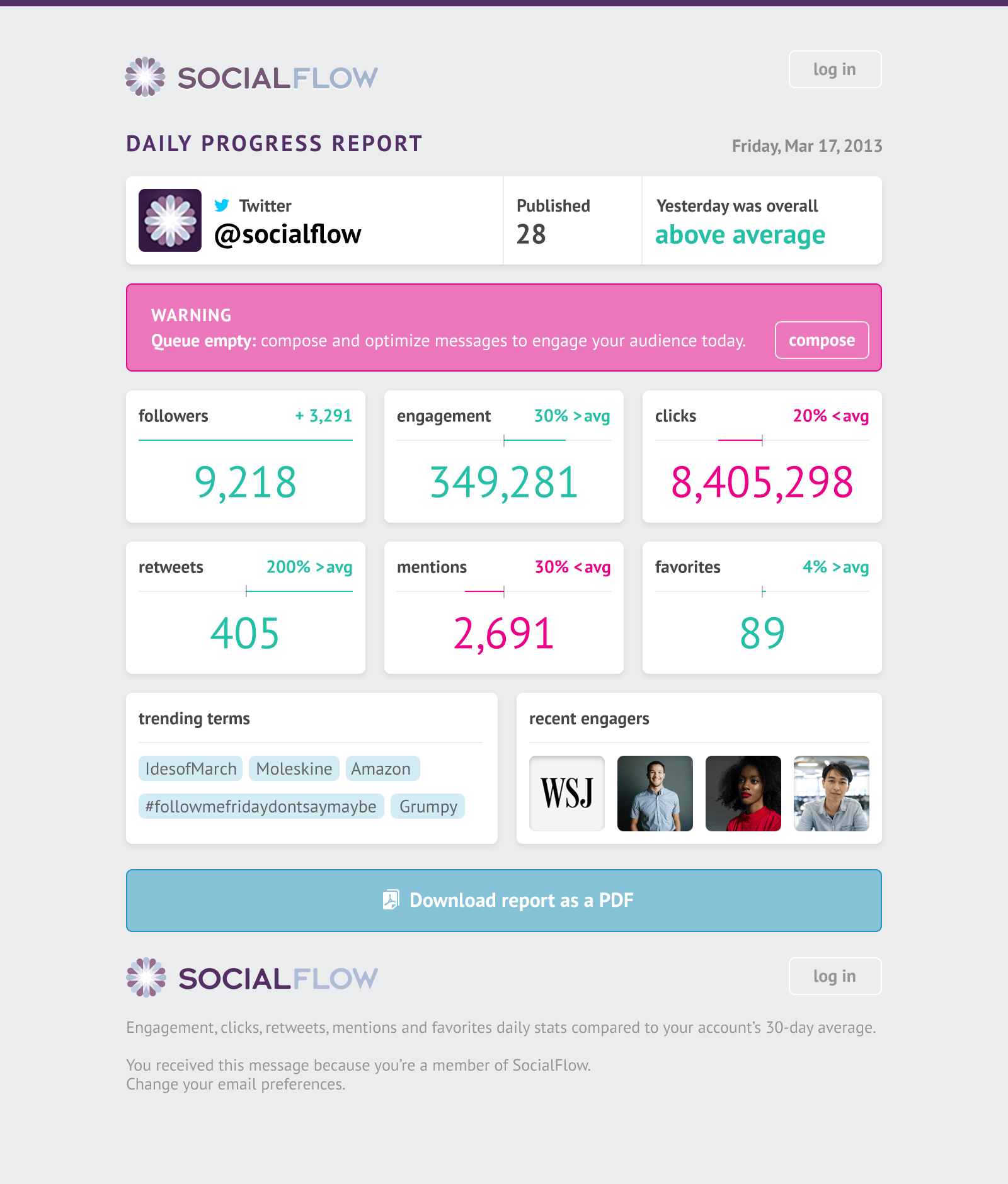
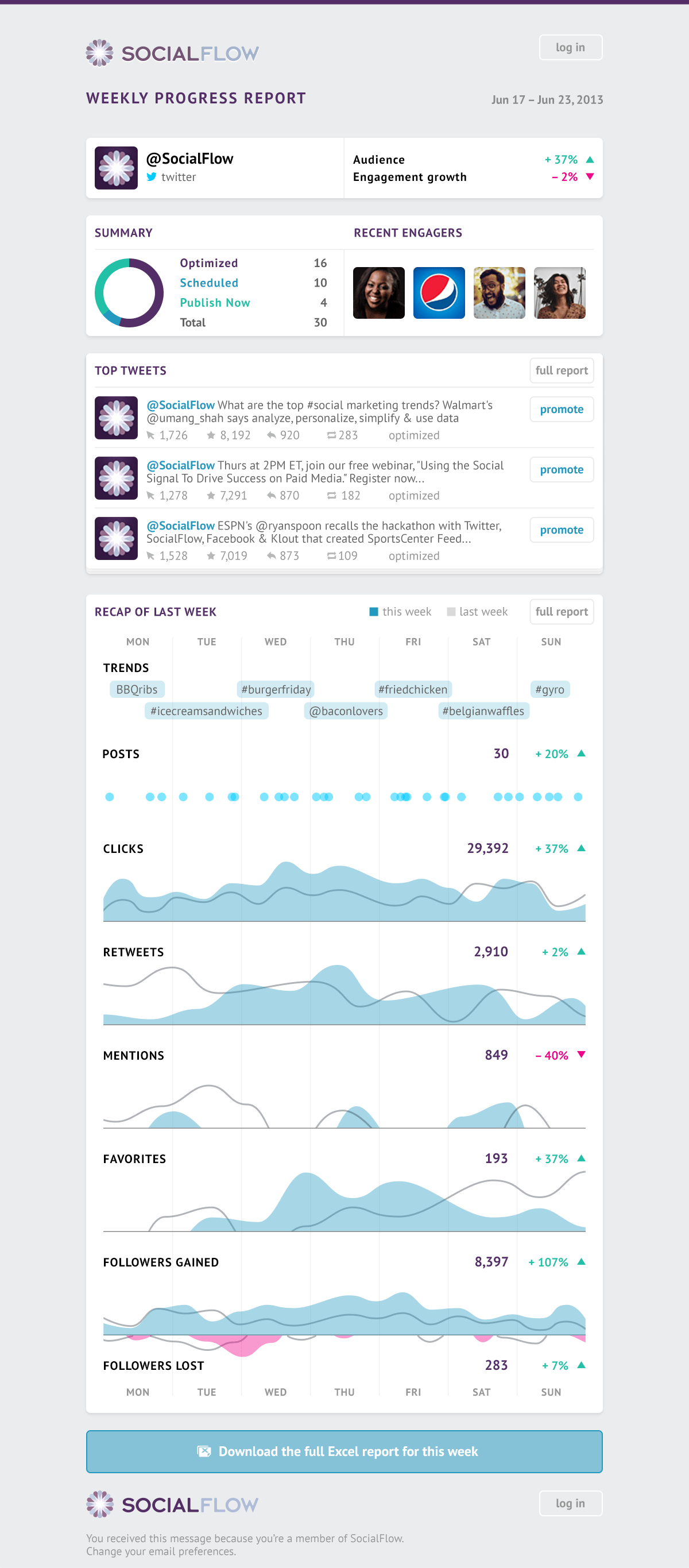
EMAIL REPORTS
Email reports to keep our clients updated on key performance metrics accomplishes two things:
Demonstrate how SocialFlow is delivering value along key metrics that all social media managers care about—while incentivizing value-add actions, such as paying to promote a post opportunistically.
Is pushed to the stakeholder without them needing to remember to check, in a format they could easily forward to their stakeholders to prove their own accomplishments. If they get a promotion, we'll continue to win their business.
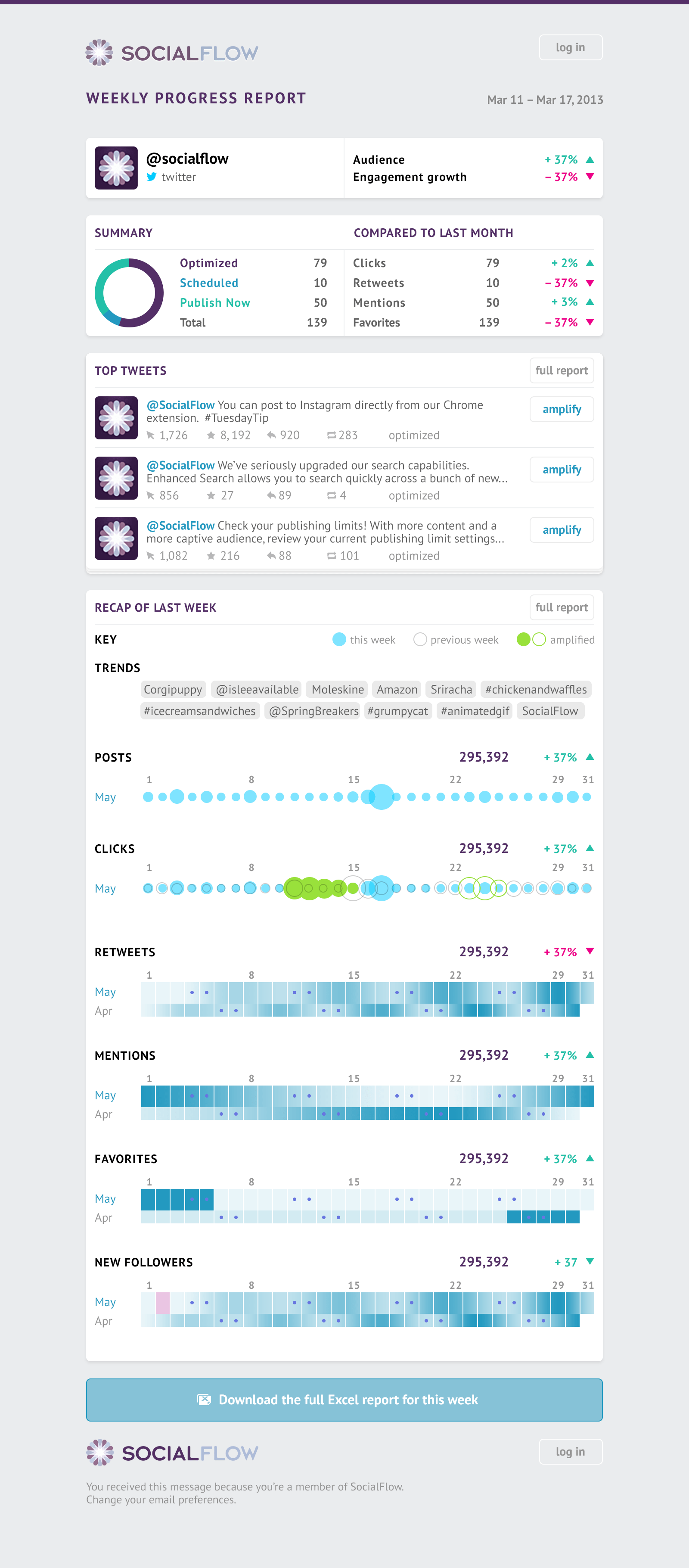
COMMAND CENTER
●●●
Starting with a blueprint wireframe to 1) align sales, account management teams on shared goals, 2) validate desirability with current and prospective customers, and 3) assess feasibility and viability with product and executive stakeholders.
●●●
The first iteration of the command center, built for clients who had large touch-screen screens in high-traffic offices, which also allowed us to build the SocialFlow brand within the organization as leaders in social media insights.
●●●
The next iteration of the command center, reorganized to incorporate other products in the suite (in this case, Tally, a product to help observe your Twitter influencers), more emphasis on the timeseries of your post performance inline with your active audience (similar to stock price charts plotted above the trading volume for context).
MOBILE APP
SocialFlow at the time was primariy an enterprise social media management tool beloved by publishers who often had too much content and needed help optimizing the stories that should be posted to their social channels at the right frequency to maximize engagement without spamming their audience. While our clients primarily used desktop to queue their messages and run reports, there came increasing demand for a mobile app to handle another set of use cases. Instead of replicating desktop but smaller for mobile, we focused on only the use cases that our customers needed on the go that couldn't wait until they got back to their desk.
Quick review and editing of the message queue
Checking to see their queue and published messages—how are messages ranked? Which ones sent? Which ones are coming up soon? Color coding for different types of publish options (optimized, held, scheduled) allows for quick skimming. Or, search for specific messages to modify, hold, or send immediately.
Timely paid promotion
If an organic post is gaining traction, power it up by paying to promote it, just in time while the message is still relevant.
Create a post for now or later
Livetweeting an event and still want SocialFlow's tracking on each message? Compose and post through the app instead of having your laptop out.
Pause publishing
If you're livetweeting an event and don't want a queued post to interrupt your session, you can pause publishing from the queue on one or more accounts. In the event of a major event, pause publishing also acts like an emergency e-brake to quickly stop all accounts that you manage from automatically publishing.
Trusting the algorithm
Why use SocialFlow instead of a service that can analyze past performance to tell you to always schedule for Tuesdays at 3pm?
One metric that's often the a-ha moment for clients to answer that question is Active Audience—the number of followers who are online now and actively engaging. By taking in the entire Twitter Firehose of all activity happening in realtime, we look at the followers of the client's account, and determine if they're active by detecting if they tweet, click, favorite, or take any other action.
Active Audience is also only one of several factors used by the algorithm to determine when to send which tweet organically. Tweeting solely based on a high active audience is like walking into a party and immediately hyping Beyonce's new red carpet look just because she's on the top of your mind. In reality, you'd take the pulse on the room, then jump into the current flow of conversation and match the mood—once the conversation drifts to what to wear to their cousin's black tie wedding, you'll now have the perfect opening to drop your Beyonce knowledge. On SocialFlow, the text within the tweets that your Active Audience is engaging with helps inform what might be trending within your unique audience, so that the algorithm is able to slot in the right tweet, at the right time, to the followers who are active right then. Based on both audience and language, each queued message displays a real-time (yes, it refreshes live!) score.
Even though the mobile app was kept lean to quickly deliver value to customers, these features carried over from the desktop app helped strengthen the value perceived by our customers—that they can trust the product to supercharge their work performance in less time.
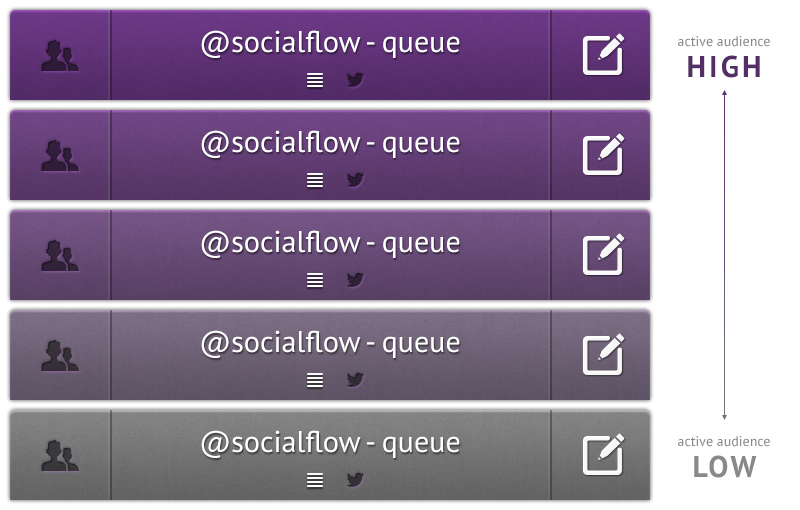

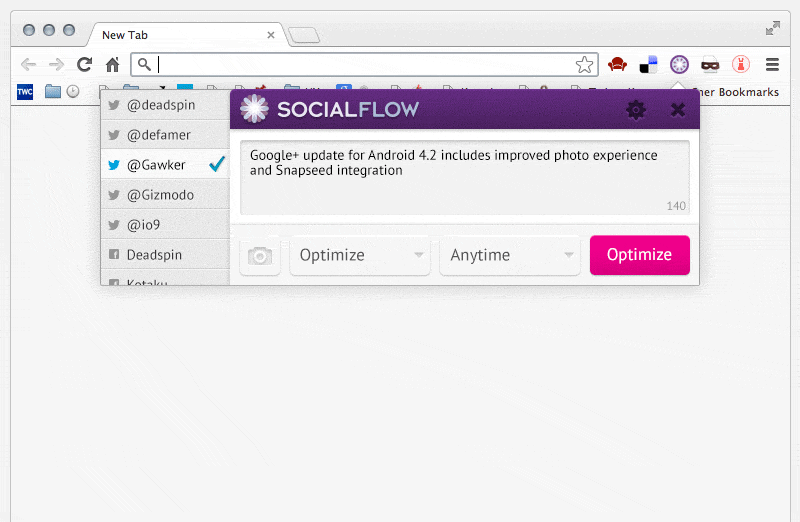
BROWSER EXTENSION
Similar to mobile, the browser extension became another way to streamline workflow—optimizing for the best performance rather than urgency (optimize publishing the post for anytime), and easily switch to other modes if needed (schedule for a specific time, publish it immediately, or hold it in the queue to edit later). A lean little tool that cuts out the majority of features, focused solely on publishing the link.
REPORTING
Seeing engagment metrics is always important in social media—and when your value prop is getting your clients more engagement without any extra work, having your reporting tell a story is even more important.
Engagement Map
Allows clients to see the impact of organic (purple) and paid promotion (green) on a message over time. What was the lifespan of this message? Seeing the proportions of different types of engagement can also lead to insights that seeing summed numbers alone would disguise—did this message get far more clicks on the ink, but comparatively low retweets? Did the paid effort help give organic a second wind and lengthen the saliency of the message?
Metrics
Large numbers to make scanning easy, differentiating metrics by organic and paid. The divider line becomes a subtle hint for percentile—is 947 retweets a lot for this account? At 23 percentile, no, it's not.
Engagers
Who are the top influencers on the performance of this message? Jump into the conversation to engage with these accounts.
Performance by Segment
Who's engaging and how? Is this tweet generating more new followers than usual? Are people discovering this tweet while searching or stumbling upon it on their timeline? While only gender, device information, and placement (timeline or search) is available in V1, this section could scale in the future to show 3 dimentions of data.
Engagement Map
For publishers—are Americans responding to international news more? Did engagement first start on the coasts then cascade through the rest of the country—how did this story become viral?
For brands—where did this style of shoe resonate? Can we use this to inform how we stock our stores or whether we release this style next season?

marketing & ideation
marketing & ideation

CASE STUDIES & CONCEPT EXPLORATIONS
One challenging difference between customer development at SocialFlow compared to other startups I'd worked on in the past is keeping pace with the constantly-evolving social media industry. When you're building a trip-planning app, customer lifestyles, habits, and problems are fairly stable, and solutions you're pairing them with are also predictable—it's not every day that the laws of physics will change and enable a vastly different set of solutions and render previous solutions obsolete. But when building on top of Facebook, Twitter, and G+, their platform updates were a double-edged sword—some updates enabled you to offer new solutions to customers that previously wasn't possible, while other updates changed your existing customers' problem space and the value of your solution.
Since the ethos for our social media partners was "move fast and break things", we had to match that pace if we wanted to continue succeeding on their rails. SocialFlow's product leadership kept the startup mentality alive—co-founder Frank Speiser had an uncanny ability to innovate by connecting the dots in a way that no one else sees. Having experience working in agencies helped immensely in this environment—where there are always infinite creative solutions that can be realized in an infinite number of ways, and you're pushed to rapidly prototype to test which ones survive contact with the customer and market.
Partners, clients, and our internal team were all learning together. From working with Stuart Weitzman to test messaging in different international markets, to ideating how emerging technologies like Watson could empower our solutions, and re-imagining how workflows could change as our focus shifted from organic to paid.
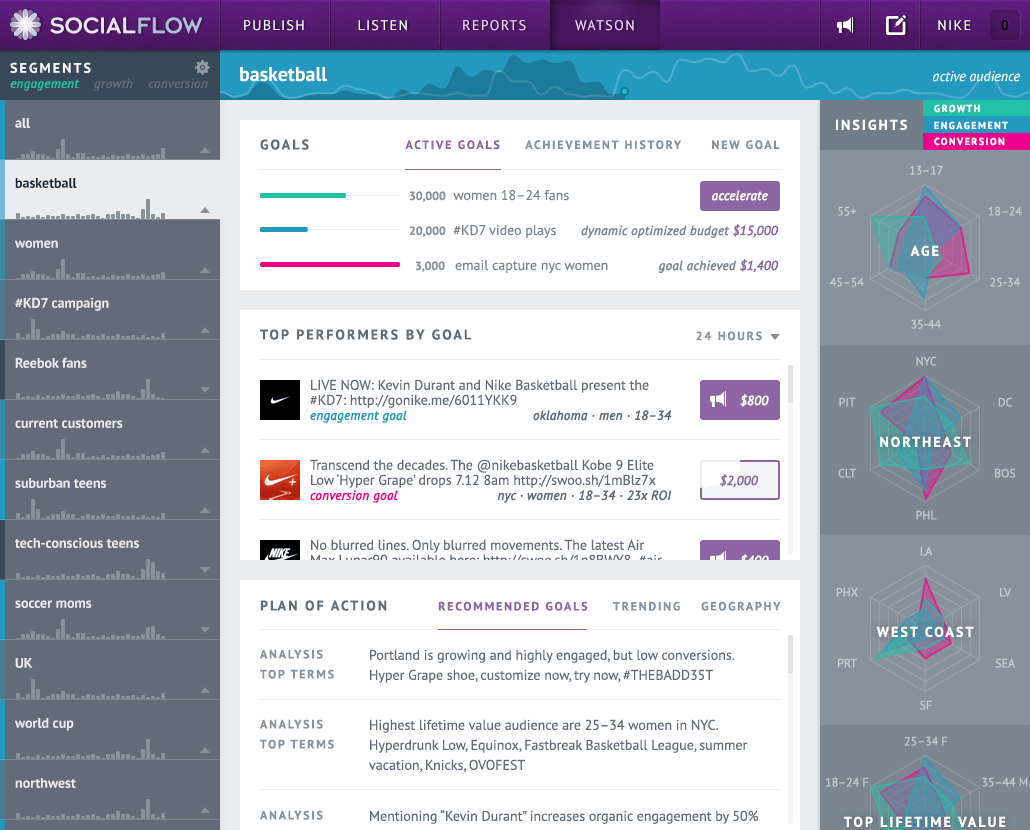
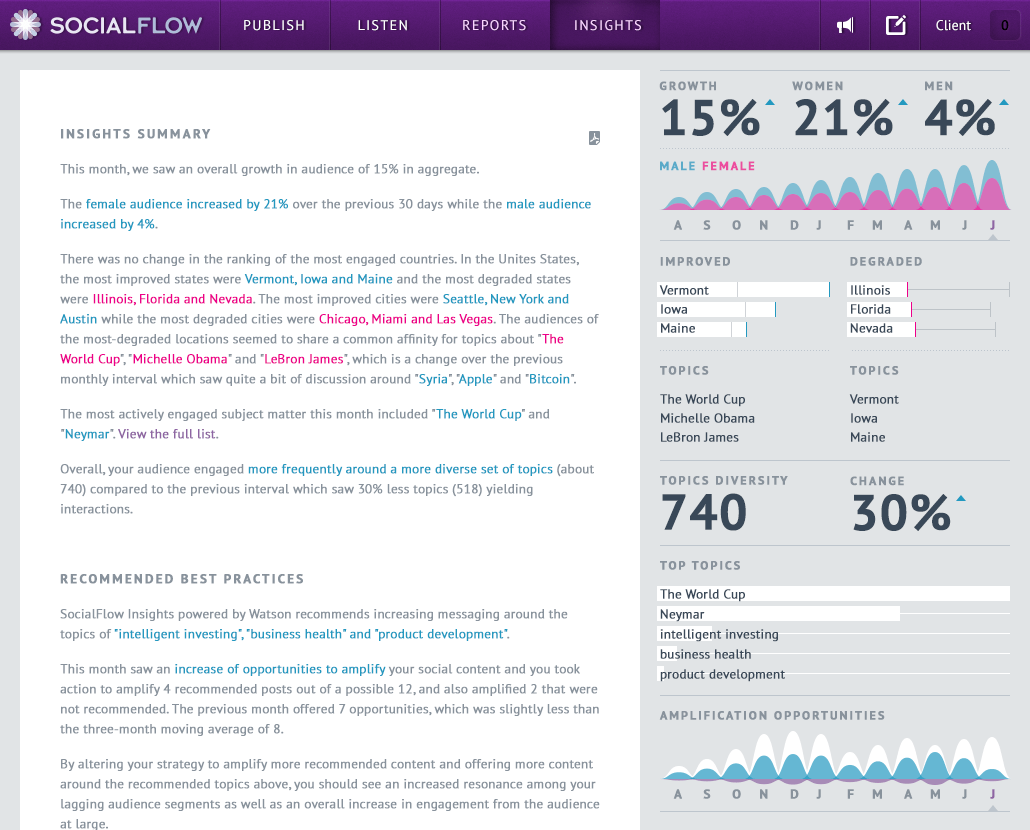
HOW INSIGHTS DRIVE BEHAVIOR
One surprising problem with social media advertising is that it's almost too measureable compared to TV and print. It's easy to be distracted by the myriad metrics and lose sight of your goals to grow your audience, engage meaningfully, and present a value prop that converts this audience into subscribers or a product purchase. One way to light the way through the jungle of data is a goals-approach to measurement and repositioning actions so that everything is service of reaching a defined goal.
This was our winning entry to Facebook's Preferred Marketing Develop Innovation Competition: The Era of the News Feed, designed so that our UX mirrored how our account managers collaborated with clients—understanding what success looks like, ensuring they're working towards achievable evergreen goals that's true for every client, creating campaigns to achieve their unique social goals, and helping them use the channels in creative ways to gain business insight.
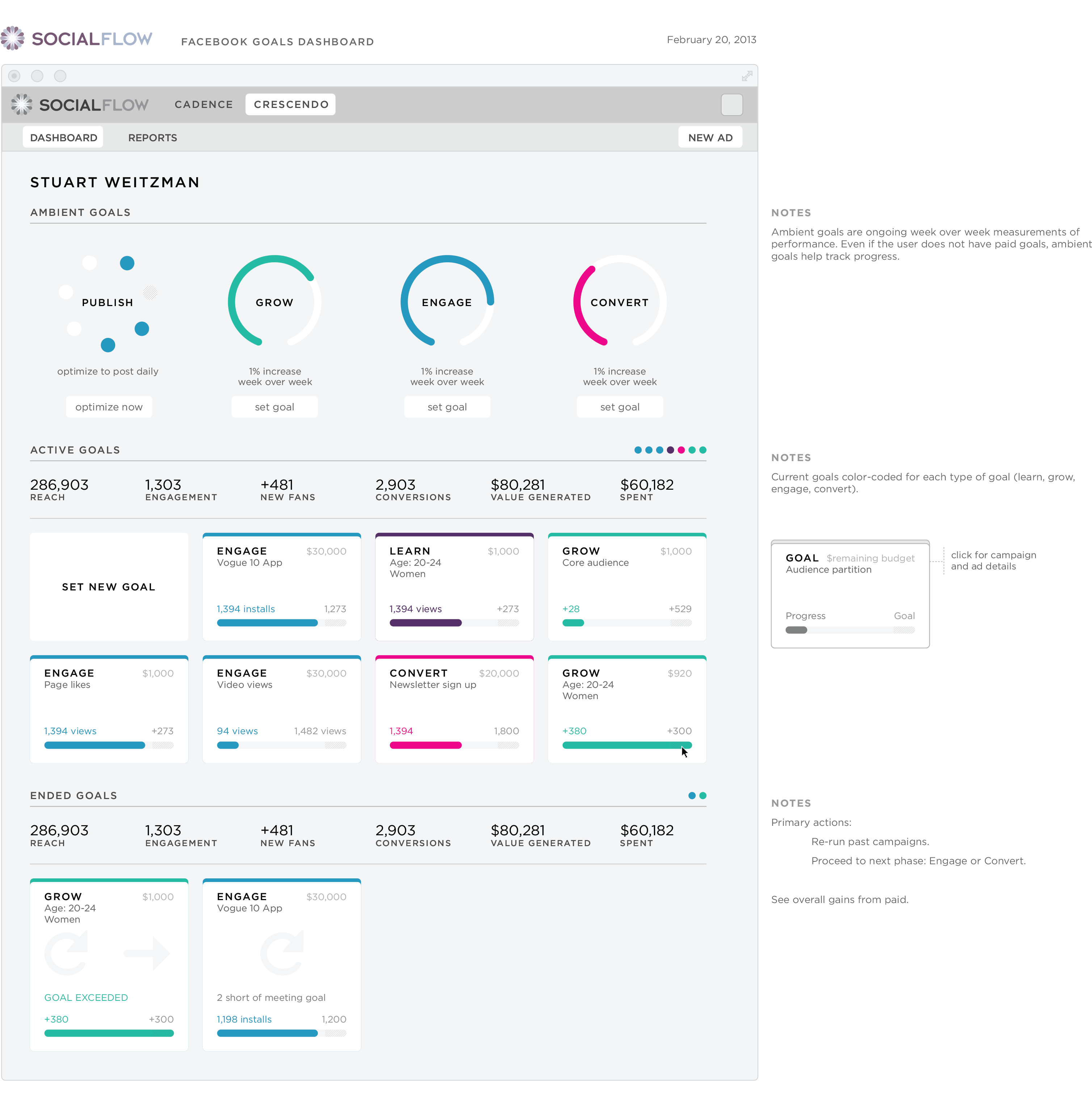
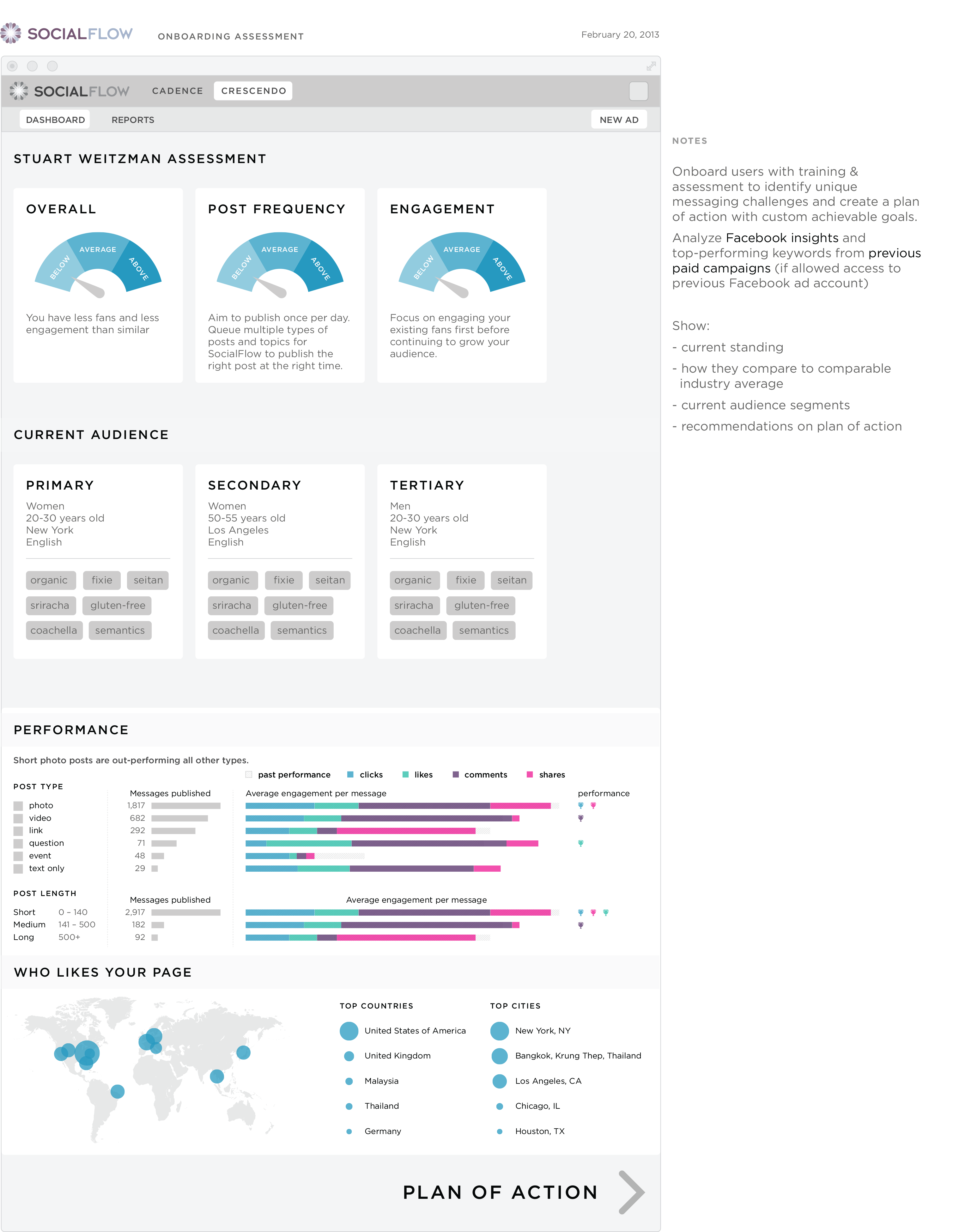
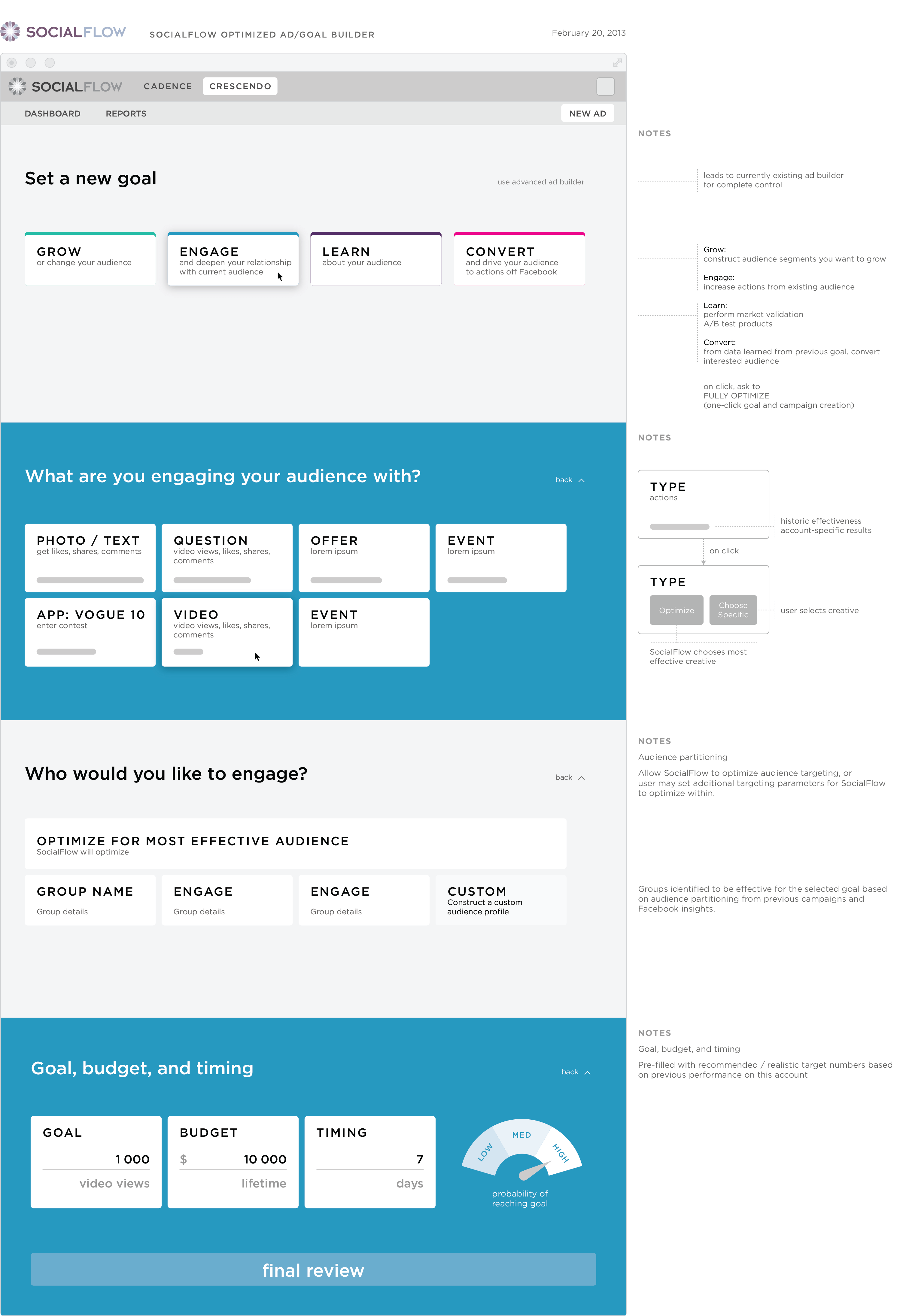
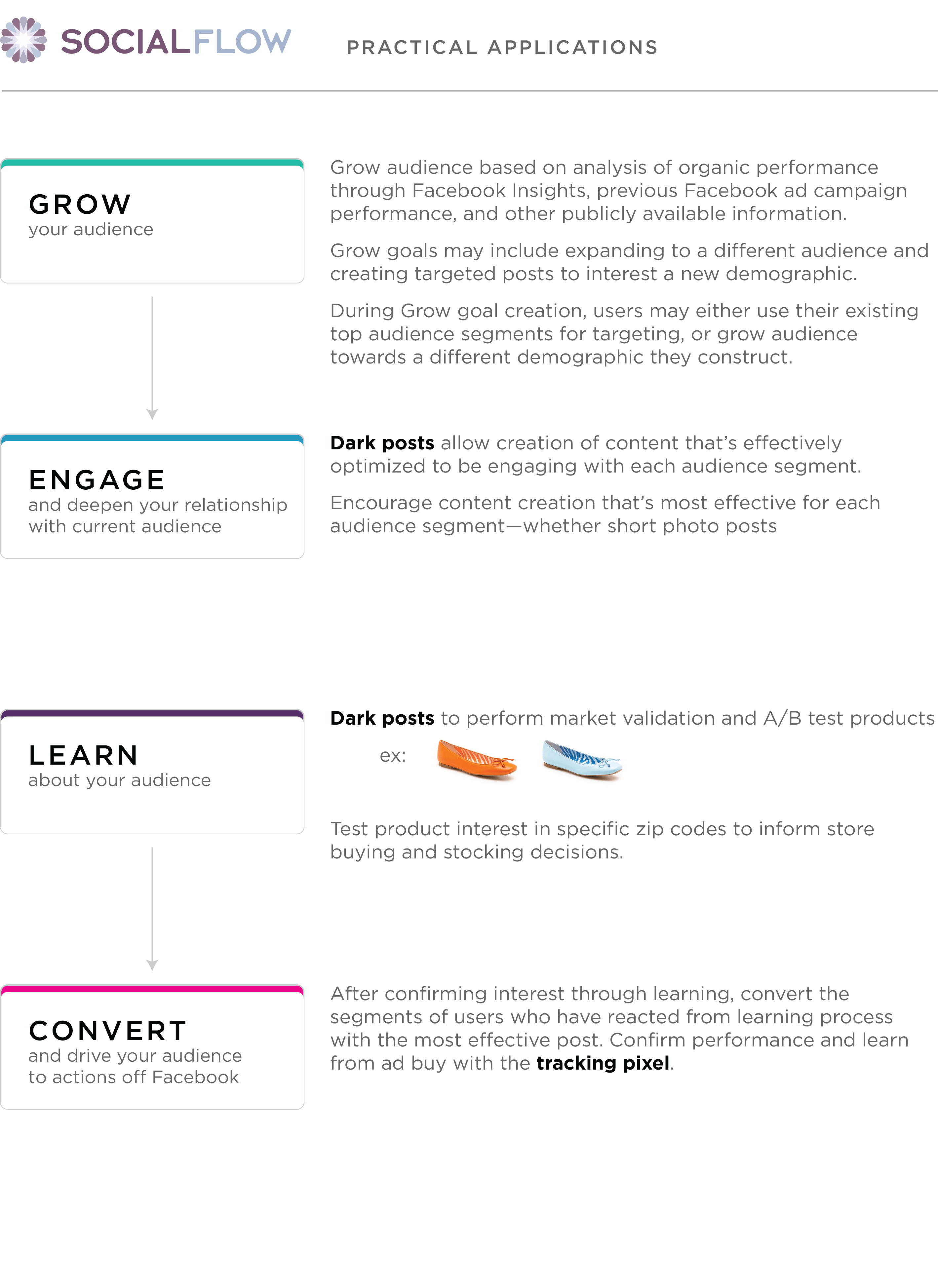
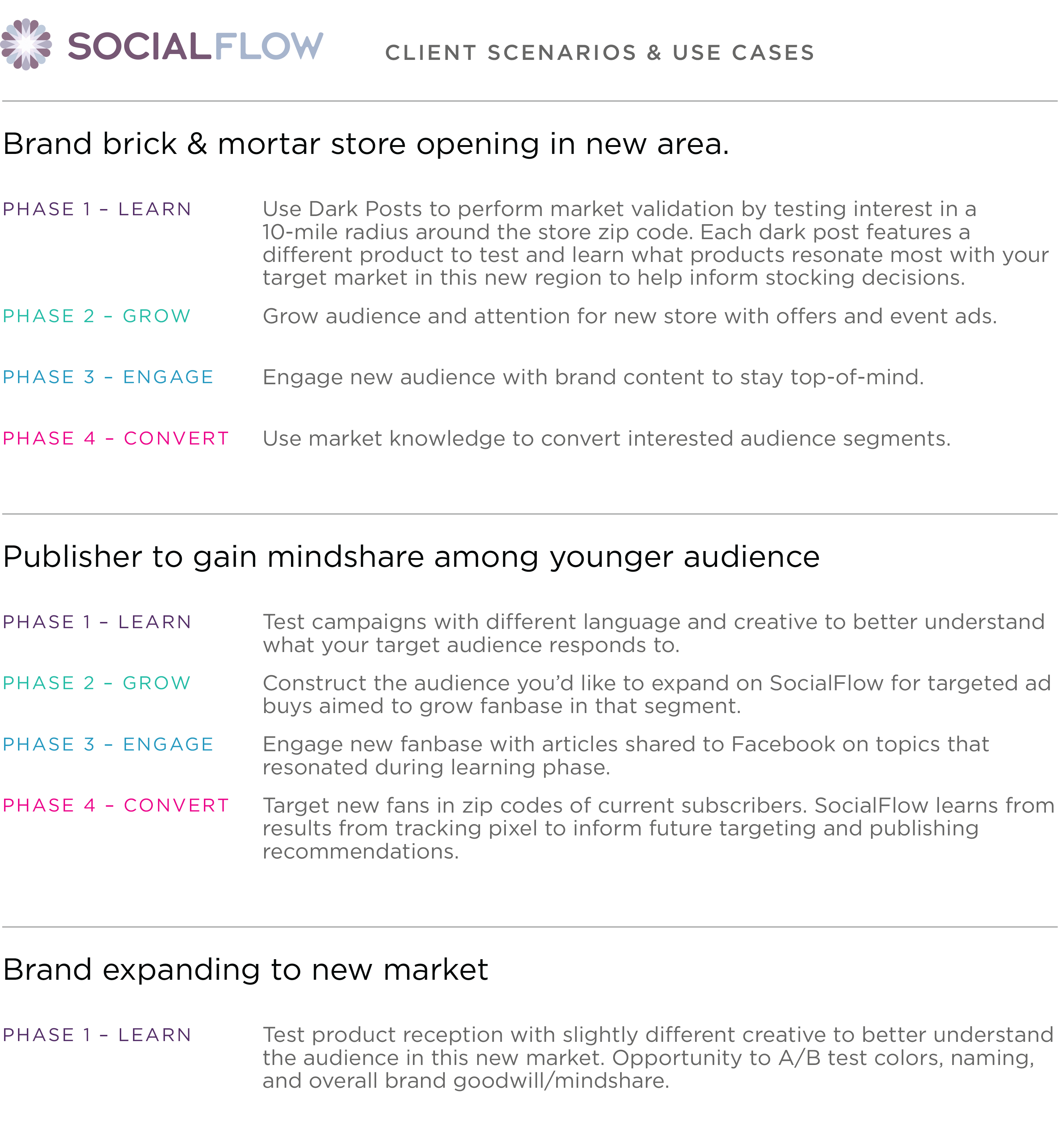
CREDITS & MANY THANKS
SocialFlow took a chance on hiring me as I transitioned from an all-purpose designer to a full-fledged product designer. Prior to SocialFlow, I had worked in boutique agencies where the work evolved from print to digital, and static to web/mobile apps. The size of clients I had worked with were two extremes—either Fortune500 piloting a new initiative or startups getting their first product off the ground. I had only worked from ideation to launch—and had no experience iterating on an existing, complex product with paying customers who relied on the software for critical work that touched millions of people. I also didn't have experience being embedded within a company with sales and account management departments—seeing first-hand how features that sell aren't always the features that get used, and feature requests from potential customers are categorically different from the requests of our paying users.
I also got to work with an engineering team who taught me how to SSH in and pull, and patiently reverted my revert and fixed everything that my git push origin master overwrote. From my manager, Matt, I got to learn Kanban, lean coffee retros, affinity mapping, and so many processes to help groups of people surface insights, have tough conversations, and collaborate in productive ways without a ton of unnecessary procedural overhead. Above all, he opened his network to me, gave me my first professional speaking opportunity, brought me along on important meetings, and kickstarted my product design career.
SocialFlow was a great balance between a startup where you wear many hats and get to experience how each part of the company worked, but also the benefits of a larger company where you can fast-track your learning by being surrounded by world-class colleagues. I was lucky to have had this opportunity to grow and learn—and as we used to say—"I'm proud to be a Socialflower".

